



























































































































































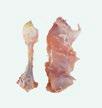

Another smart poultry processing solution from Meyn; fully automated, fl exible, and digitized. Make an appointment for a sneak preview of our new in-line drum and thigh deboning solution.

Poultry breeding is serious business. After all, breeding is not just meant for raising chickens in the backyard. On the contrary! Breeding is the basis for commercial poultry farming and as a result to produce valuable food for the world population, either meat or eggs.
On the layer side, breeding is focused on obtaining vigorous chickens which produce as many eggs as possible during their life time, at the lowest possible cost price. Automatically, the males of these strains are unsuitable for meat production. As a result, it has been common use for decades that male chicks of layer breeds are culled, immediately after hatching. And this was accepted by the public. But particularly in Europe, there’s a tendency to not any longer accept this practice. That started with layer welfare in general already, early this millennium. Under pressure of NGOs, keeping layers in traditional cages was no longer accepted, which eventually resulted in a directive to fully ban traditional cages in 2012.
It is most likely that soon a similar directive will be accepted in the EU about ending the culling of day old males, from layer breeds. In Germany this legislation has been accepted already since January 1st of this year and with no doubt will also be accepted across the EU in the time to come. That’s not unthinkable, since only in the EU 330 million male chicks are culled annually. Quite a number!
Various initiatives are in process to find solutions for this problem. Like raising males and process these into “maleburger”. Lidl supermarket is offering these in The Netherlands as a byproduct of Kipster layer farms. But this is only possible on a very limited scale and both practically
Ad Bal
Editor aviNews International


+31 629791019
avinewsmagazine@grupoagrinews.com avinews.com
and from a sustainability and commercial point of view not very feasible. Also using dual purpose breeds is not the answer.
Much more promising is gender detection in the hatching egg, meaning that gender of the chick can be determined in an early stage during incubation. Four methods are already available in Europe and are being used in commercial hatcheries.
Of course this expensive technology will make a layer chick more expensive. For that reason a positive aspect of modern breeding is that hens nowadays are much longer persistent and productive than in the past. However, layers which are producing 500 good quality eggs truly deliver top performance and that demands skilled management of such flocks.
In this edition of aviNews you can read an extensive and in-dept article on the alternatives for chick culling, and gender detection during incubation in particular. It opens up new horizons in layer breeding, which will for sure be the way forward.
Another article dives into the art of keeping layers in top condition and how layer farmer Peter Janssen from The Netherlands manages his layer flocks to reaching this goal. Not just the skills of Peter are worth knowing. Also keeping a good climate inside layer houses largely contribute to keeping layers productive during their entire life span.
Again an interesting edition of aviNews in which you read all about the above mentioned and other topics.
Enjoy and learn!
Ad Bal
Eduardo Cervantes International Consulting - Productive and Innovative Management in Poultry Processing


It is known that Social Media are the most effective means to promote and successfully maintain a new product or service. High- performance athletes and people who belong to the show business are the ones who get the most out of it.
Prepare breeder hens for optimum production
With continuously improving genetics, the current broiler is robust with low mortality, excellent feed efficiency and high yield. This also applies to the broiler breeder, which the customer would like to see producing more and viable chicks.
Every year, around 330 million one-day- old male chicks are culled in the egg industry in Europe after hatching. The reason is their inability to lay eggs and the very low growth rate, making raising them economically infeasible.
Caged and cage-free laying hens
Rosangela Poletto
Member of the Scientific Committee of the Certified Humane Program Professor at IFRS-Campus Sertão - Brazil

Production systems that raise cage- free laying hens -which live loose in barns with or without access to an outdoor area- allow the birds to express natural behaviors in accordance with the animal welfare principles.
Gizzard and proventriculus as a health marker
Edgar O. Oviedo-Rondón
North Carolina State University, Prestage Department of Poultry Science, Raleigh, NC
The stomach in chickens is subdivided into two parts, the proventriculus (glandular stomach) and the ventriculus (gizzard). The proventriculus is the organ producing acid and enzymes. The gizzard is the muscular stomach and pacemaker of gut motility.
Martha Pulido
Associate Clinical Professor. Poultry Diagnosis and Research Laboratory (PRDL). College of Veterinary Medicine, Mississippi State University.
The great diversity exhibited by Salmonella spp (S.) is one of the most critical characteristics that must be considered for its control. While it is true that more than 1,500 serotypes are now included in subspecies enterica.
Artificial Intelligence applied to increase the consumption of chicken meat- Some Ideas
Paul Welten Breeder Specialist Cobb Europe
Dr. Ana E. Blanco Head of Supply Chain Management respeggt Group
Salmonella Infantis: an emerging serotype that has become a resident?
55
G. Talegón1 , L. Aguirre1 , H. Kadardar1 , M. Frikha2 , J.C. Abad2 y G.G. Mateos1
1Polytechnic University of Madrid 2Cobb Spain, Madrid
Using whole wheat as a supplement to commercial feed is not a new concept. It has been a common practice in Northern Europe for more than 30 years (Forbes and Covasa, 1995; Engberg et al., 2004). Compound unpigmented feeds for broilers contain approximately 50-60% wheat.
North Carolina State University, Prestage Department of Poultry Science, Raleigh, NC
The 26th World’s Poultry Congress held in Paris between August 7 and 11 was a success. The Congress originally planned for summer 2020 was postponed twice due to the pandemic. However, organizers were able to modify the traditional format of this quadrennial event and develop a hybrid event.

Manuel Contreras
DVM. MS. Dipl. ACPV. Special Nutrients/Agrimprove, Miami, FL., USA
A popular belief used to explain why mycotoxins are not identified in significant concentrations in feed analyzes performed in clinical cases where lesions are compatible with mycotoxicosis, is that these lesions are caused by mycotoxins’ accumulation in several organs for long periods of time.
62 68
What you didn’t know about the 33rd Poultry Science Symposium and the WPSA UK branch!
Dr. Helen Masey O’Neill1 and Maria Camila Alfaro2
1PhD. Chair of Symposium-WPSA UK Branch. Innovation Director at ABAgri
2DVM. MS. KAM aviNews International
During the past 22 to 24 August, the WPSA UK Branch held the 33rd Poultry Science Symposium at Clare College, Cambridge. This year the symposium was focused on “Pre-and Probiotics: Nutritional, veterinary and production perspectives.”
Interview with Gert Jan Oplaat
President AVEC
AVEC is the voice of Europe’s poultry meat sector. Newly elected president Gert Jan Oplaat strongly advocates the value of poultry meat and getting it on every table of European families. “My goal is to tackle an array of challenges. In particular bridging the gap with the “Brussels bubble”.
The responsibility for the articles, reports, press releases and communications falls exclusively on the authors. The editor is only responsible for his articles or editorials. Neither the publisher nor the authors assume any responsibility for the damages that may be generated, whatever their nature, as a consequence of the use of the data and information contained in this magazine.


Edgar Oviedo Professor, Extension poultry specialist Technical Direction Ad Bal Editor avinews International
 Eduardo Cervantes International Poutry Processing Consultant Technical Direction
Eduardo Cervantes International Poutry Processing Consultant Technical Direction
Use of whole wheat in broiler feed: advantages and disadvantages
Farm report: The art of keeping layers in top condition
Accumulation and elimination of mycotoxins in poultry

 Eduardo Cervantes López International Consulting - Productive and Innovative Management in Poultry Processing
Eduardo Cervantes López International Consulting - Productive and Innovative Management in Poultry Processing
It is known that Social Media are the most effective means to promote and successfully maintain a new product or service. Highperformance athletes and people who belong to the show business are the ones who get the most out of it. These amazing achievements are measured by millions of fans who rate their performances with a “Like”
Chicken processing has always had two complementary objectives in the following areas:


Pre-slaughter and Processing:
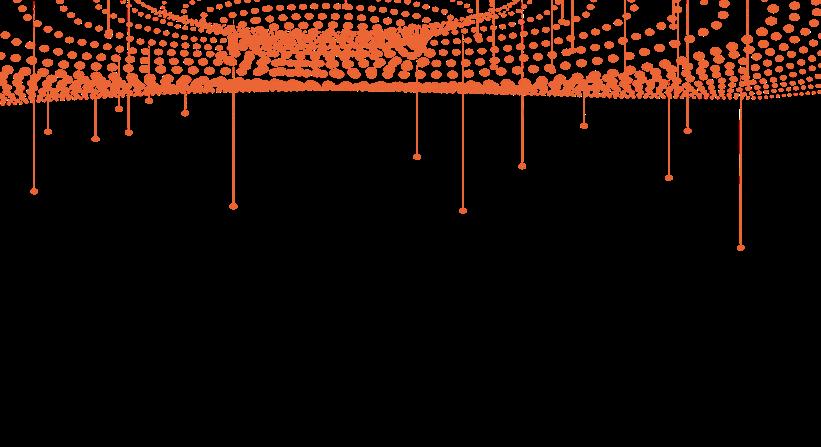
Reduction of seizures detected during slaughter, as a result of inadequate monitoring of a series of details and micro details that have been commented on in previous articles, during the operations of: Enclosure, capture, caged, mobilization of cages and containers to where the vehicles are and their loading. Likewise on the plant.
Marketing:

Strategies to increase the consumption of chicken meat and its by-products.
What has been the purpose of focusing attention on these two topics, located outside the facilities of the processing plants, that help increase the amount of meat that goes to market?
Pre-slaughter:
By lowering the number of affectations in the quality of the chickens that arrive at the plants, a greater number of kilos of firstclass muscles are available, which, when processed, are transformed into Grade A Quality meat. This additional volume reduces the cost of a kilo slaughtered, a condition that improves the level of competitiveness in the market.
Marketing:
As the sale of chicken meat and its by-products increases, the processing plants must grow to satisfy this gradual demand increase. For this purpose, they will have to increase the speed of slaughter and the number of people; also evaluating the possibility of working a second shift.
This article aims to share ideas and concepts that work very well in other sectors of the economy using Artificial Intelligence.


Everything we know as Artificial Intelligence is supported by a set of Instructions- algorithms, designed to know people in detail through the analysis of the following, among other aspects: Items they buy Brands Colors Shapes Frequency
This strategy must be implemented using some details offered by neuromarketing: Create a somatic imprint Awaken desire Increase it as time goes by Show where and when to satisfy it Have representative icons of society: Influencers
It is worth highlighting two cases that have stood out over the years:

In Central America, the successful positioning of a chicken that has become an icon in that region always attracts attention. This organization fulfills the dream of any producer: Your product is not only a commodity, but also fully satisfies the needs of the final consumer.
The famous KFC chicken that is positioned worldwide is a franchise that buys raw materials from processors in the countries where they operate. Prepare the chicken meat with a marinade that has the same flavor everywhere they offer it.
The above reality should be the trigger to massively promote the consumption of chicken meat as an
Irreversible Dream: “That the environment of the cities smell continuously of the strong smell of fried or breaded chicken, ready to consume it.”
Supermarkets can be associated with Micro-societies where two odors are correctly managed, allowing them to strategically filter so that customers perceive them, go crazy with them and decide to buy these products: Bread and Fried Chicken and occasionally chicken wings. The Publix Supermarket chain in Florida (USA) leads the consumption of this last product.
Many years ago, the water we consume was a generic product. Some companies analyzed this detail and decided to identify it. Currently, the water portfolio is so broad: “You can find something by the activity carried out.”
Making an analogy, raw chicken meat is a generic product. In general terms, the balanced feed – I think – that the birds consume is the same. The companies use different proportions of raw materials –grains, similar vitamins, and minerals.
So, the question arises: Is it possible to offer the consumer chicken meat with a different flavor?
The answer would be YES.
Reflection: On one occasion, I had the opportunity to consume roast chicken fed with a dose of moringa mixed with balanced food. It was an exciting experience. If this goal is achieved, we will be positioning processed chicken meat with a flavor that makes a difference.
Many plants marinate whole chickens, trimmed and boneless, with a brine with a characteristic flavor. If the expectations of final consumers are exceeded, an important group of fans will begin to be created, as successful artists and athletes have worldwide.
Daily advertising campaigns aimed at the different sectors of society.
Why are the campaigns aimed at increasing the consumption of chicken and its derivatives circumstantial, despite having a demand that continues to grow?

With all the advantages offered by Artificial Intelligence, it would be possible for the professionals, companies, and associations of each country to put into service a NETWORK that could be titled: “Eating Chicken”, where the members of the different stages that make up the poultry industry present their advertisements, highlighting all Science, Technology, Biosafety, etc. that supports chicken meat and its derivatives.
Reflection: What feeling does eating chicken produce? For many years I have been researching this topic taking advantage of my visits to different Latin American countries and Spain. Unfortunately, I have not been able to reach a consensus. Achieving it as the well-known drink Coca-Cola has done, which has the world’s highest sales per minute, is an exciting challenge. It has positioned this carbonated drink as the Spark of Life: Happiness. Lead advertising campaigns in December and other months of the year. In addition, it is one of the sponsors of continental and world sporting events.
Additionally, all the nutritional benefits and their collateral effect on our immune system ensure a good healthy body condition.
How will a very dynamic NETWORK carry out marketing research to define, among other aspects, the following:

When you eat chicken, what feeling does it give you?
Favorite chicken pieces
Purchase frequency
How many times do you eat chicken daily?
Places
Presentation: Whole, Trimmed, Boneless, etc.
Which members of your family eat the most chicken? Why?
Other alternatives to encourage consumption would be: Invite citizens to help initially design the mascot in each country, offering prizes in kind to the group of preselected and finally selected mascots.
Invite to make a song about the chicken industry, which, when its lyrics and music are heard, initially becomes viral in each country and then define through a contest the best musical work to be the Latin American anthem.
Preparation of a work in Cartoons such as the current Disney musical: “Encanto”, showing each phase of the chicken industry to offer consumers a Healthy, Nutritious, and Economical Chicken Meat.
Build a Spectacular Natural Park in each country, creating a magical environment that leaves a somatic mark on visitors. It could be called “Poultry World”, where the history of this commercial activity is explained and shown, the technology used in the different areas, and a large food court so that attendees can enjoy all the products offered to the community.
A priority issue is to inquire among people about what they would like chicken meat suppliers to offer them so that you can enjoy new experiences when preparing and consuming it.
With all this database, strategies to increase the consumption of chicken meat and its derivatives would begin to be directed, as current social networks do.
Artificial Intelligence applied to increase the consumption of chicken meat- Some Ideas DOWNLOAD THE PDF
With continuously improving genetics, the current broiler is robust with low mortality, excellent feed efficiency and high yield. This also applies to the broiler breeder, which the customer would like to see producing more and viable chicks.
To maximize the genetic potential of broiler breeders, management details are important. The foundation for high productivity is in rearing. To achieve peak production, prepare pullets in optimal conditions for good persistency and low mortality later in lay.
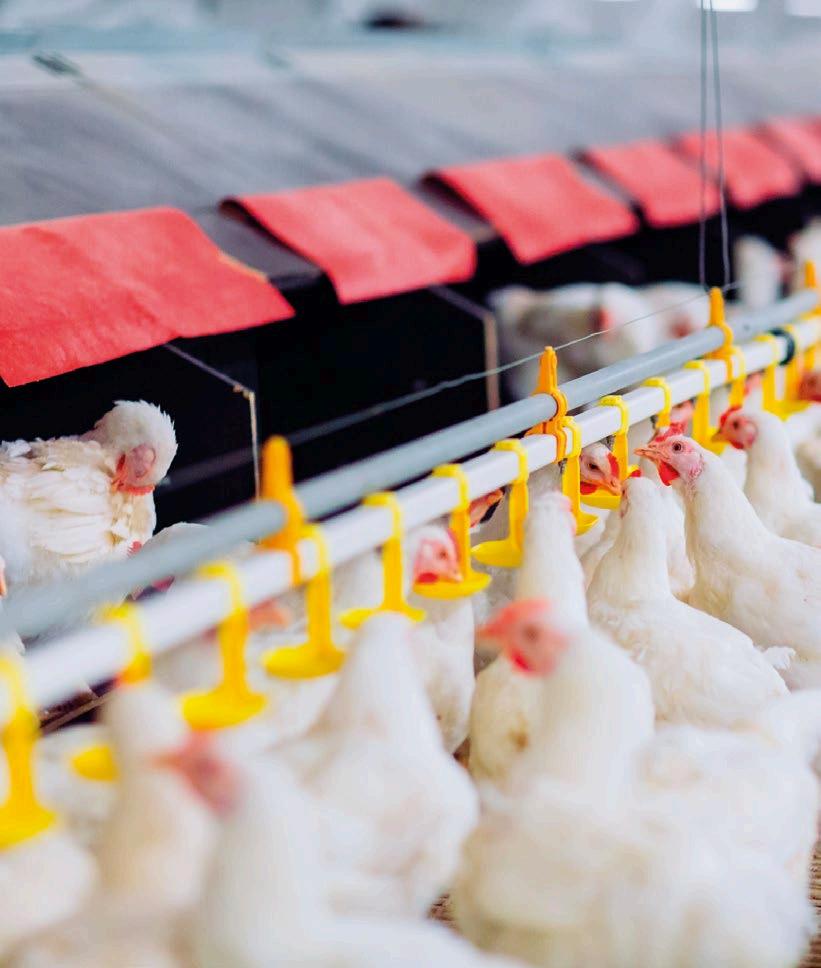
Focus on uniformity, body conformation, bodyweight profiles and feed management to create the ideal preparation of the pullet.

The goal for the end of rearing is to have a sexually uniform flock with the correct body conformation for age. With high sexual uniformity, birds increase production faster into lay. Feed and weight gain can also be better managed and there will be lower mortality in early lay.
Flocks that peak high (88-91%) are flocks that increase production fast in the first three weeks.
Production should increase from the first week, with a 1-3% weekly production increase rising to the second week by adding a zero. This means that 1% should go to minimum 10%, 2% to minimum 20% and 3% to minimum 30%.
From the second to third week the production should at least double. For example, 30% in the second week should become 60% in the third week.
In the first eight weeks, skeleton uniformity is determined. In this period, the aim is to bring all chicks to the same frame size.
High skeleton uniformity makes it easier to bring all birds to the correct body conformation after 12 weeks.
Birds with a smaller frame in comparison with bigger frame birds get fleshed faster and often over fleshed on the same feed intake.
The first days for the chicks will influence how the uniformity will develop. Provide 50g feed/pullet before placement, and a floor temperature of at least 28 oC. 24 hours after placement, 95% of the crops should feel soft and pliable, indicating that the chicks have successfully located feed and water.


The second week after the chicks have reached their target weight, they should start on controlled feeding to limit growth, which will lead to competitive behaviour.
Grading done No grading Feeding issues 80 70 60 50 3 4 5 6 7 8 9 10 11 12 13 14 15 16 17 18 20 19
90

Uniformity (%) Weeks
Figure 1. Field results from uniformity curves by grading and no grading.
There is also a difference in eating capacity between the chicks – some will eat faster than others.
This influences the nutrient intake. While in rearing, the uniformity should never decrease.
To increase uniformity, it is strongly recommended to grade the birds at a young age. With grading, the birds will be split into smaller groups with the advantage of less competition for feed.
The first grading should be done at seven days – and certainly not later than three to four weeks It is important to induce good immunity in the first weeks. If the birds are being placed in other houses as part of the grading process, consider the coccidiosis vaccine and take the correct actions in combination with the correct age.
Production results have been improved by grading the flock by weight at seven days. The chicks should be sorted into three groups:
Table 1. Fleshing condition in females.
FLESHING 1-5 (%)
Week 2 3 4 Pelvic fat (%) 12 70 30 16 40 60 0 0 19 <10 60 30 >65 20 <5 60 35 >85 21 60 40 >90
The standard group should be around 50%-60% of the flock. It is essential that the different groups can be fed differently to manage them according to their bodyweights. At eight weeks, 78% of skeleton is determined. The goal is to have all birds at that age on the same bodyweight. The advantage of grading is shown in Figure 1.
Grading has a clear advantage in uniformity. If feed issues occur and there is no grading, there will be a big impact on the uniformity when the birds are on controlled feed. The birds with lower appetites will be more affected than the fast eaters.
Substantially under the desired level of fleshing very thin birds. Birds with this degree of fleshing need to be evaluated for culling.
Ideal breast shape at 12 weeks of age and the lowest fleshing condition over the life of the bird.
Breast fleshing shape at 16 to 25 weeks during early preparation for lay.
Breast fleshing shape at 19 to 25 weeks during preparation for lay.
Over sized breast muscle
Puberty starts at 12 weeks. Pullets should reach the correct body conformation by 20 weeks of age. Females need to reach the fleshing targets at 16 weeks so that the correct amount of abdominal fat will be deposited at 20-21 weeks as shown in Table 1
Birds should be graded again at 12 weeks to different carcase size. This can be done in three groups:
The small carcase birds must be fed less in relation to the big ones to get the same conformation.
Evaluate the fleshing every two weeks and use this as a guide to feed more or less.
Be sure that until 16 weeks the birds are well-controlled in condition with not too much over fleshing.


Due to the innate high yielding ability, the birds develop breast meat fast when the nutrient intake is too high, especially in amino acids.
Higher breast muscle means that more energy is required to maintain more breast meat.
For high production, females need some portion of body fat when lighting is turned up at onset of lay.
During the maintenance period until 15 weeks, the birds develop their fleshing between score 2 and 3, scores 1 and 4 should be avoided.

From 16-21 weeks, the fleshing has to increase to 3-4 so that the fat deposition will also begin in that period.
Between 21 and 22 weeks, the decision on lighting has to be made. All birds should have a fleshing condition between 3 and 4, and at least 90% should have good fat reserves on the pelvic bones before increasing light.
Modern broiler breeders are very feed efficient and need fewer nutrients to reach the same bodyweight at 20 weeks.
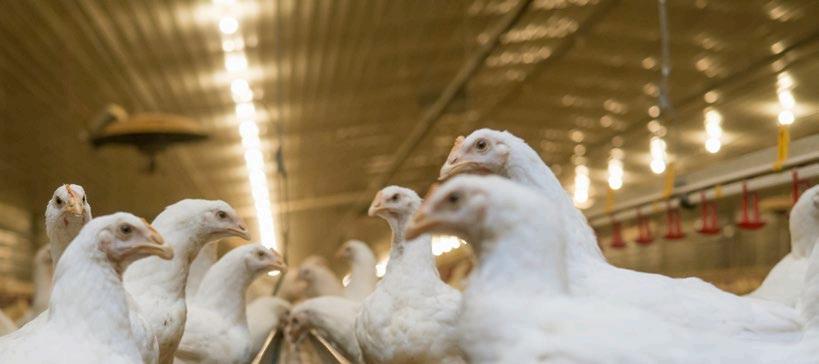
In the first four weeks, the objective is for good initial growth where the organs and immunity are developing well. The chicks have to reach bodyweight targets with not more than 5% above target weight at four weeks.
Be aware that it takes two weeks before the given feed amount will be reflected in bodyweight gain. From five weeks up to 16 weeks, the bird’s growth must be controlled. Small feed increments are given in this period. Restricting nutrient intake will limit breast meat deposition and will enhance egg production.
To be sure all birds can eat at the same time:
Feed should be distributed in the dark in less than three minutes.
The supply to the feeder lines should be fast so there are no gaps.
The layout of the farm is important; the birds should be able to eat comfortably and avoid stress.
Table 2. Increase in bodyweight gain and feed between 16-20 weeks.
A feed space of 15cm is required after 12 weeks. In the maintenance period, it is very important to maintain carcase uniformity and not to let pullets become overweight. Pullets with a large carcase must be fed differently to achieve the same body conformation as birds with a smaller carcase.
The diet should always be well balanced to meet the bird’s requirements. For example, the first 10 weeks are very important for feather quality with particular demand for methionine and cysteine.

With low feed intake, ensure that the bird’s intake of amino acids, vitamins and minerals is sufficient.

In the grower phase, lower energy diets may be used to give more volume of feed and increase feed time. It’s important to maintain the correct balance of nutrients in the feed.
Another option is to feed mash instead of crumble or pellets to increase feed time. This may not always be an option, for example with spin feeders.
From 16-20 weeks, the hormonal process starts and the birds have to accelerate growth and begin to deposit fat.
The bodyweight curve must be redrawn at 16 weeks if the females are overweight.
They should maintain this excess weight at least to 20 weeks of age to get the appropriate amount of increase in body weight.
In the period between 16-20 weeks, the females must grow at least 34%.
A third way to help increase the amount of fat is to feed a prebreeder ration with a higher energy level from 16 weeks onward.
broiler breeders
The importance of bodyweight gain is illustrated in Figure 2. Bodyweight gain of the top 25% and bottom 25% is compared versus production curves:
The bottom flocks were heavier in the maintenance period until 16 weeks.
Top flocks were below standard at 10 weeks but gradually increased to the standard.
From 16 weeks onward, the top flocks increased in bodyweight by 36.1% and bottom flocks by 27.6%.
The bottom flocks tend to cross the standard line between 19 and 20 weeks.
25%
25%
Figure 2. Bodyweight gain from 10-20 weeks.
80
60
Standard Bottom 25% Top 25% 0
100 20 24 28 32 36 40 44 48 52 56 60
40
20
Hens housed Weeks
Figure 3. Production graph hen housed.
Top flocks peaked on average at 86.8% and bottom flocks at 81.3% – a difference of 5.3%. Top flocks also have much better persistency (Figure 3).
A good investment in rearing will pay off in production. Today’s broiler breeders have excellent genetic potential. Correct preparation is essential in rearing, which means high sexual uniformity, a bodyweight gain of >34% between 16 and 20 weeks, and correct fleshing and fat reserves at 20 weeks of age.

Prepare breeder hens for optimum production
DOWNLOAD THE PDF


Every year, around 330 million one-dayold male chicks are culled in the egg industry in Europe after hatching. The reason is their inability to lay eggs and the very low growth rate, making raising them economically infeasible.
The pioneer country to end this practice is Germany, which banned chick culling in its hatcheries on the first of January 2022. The German government already stated in 2015 that they would ban this practice as soon as methods of gender identification in the hatching egg are available in the market.

The disadvantages related to the egg performance are the following:

There are currently three solutions in the German poultry sector to end chick culling: They are crosses of laying hens with broilers, where the females are used for egg production and the males for meat production. The laying performance of dual-purpose breed hens is lower than that of laying hens; analogically, the meat performance of dual-purpose breed males is lower than that of broilers.
Laying hens from dual-purpose breeds lay around 20% fewer eggs (≈ 250 eggs) than laying hens from genetic lines (≈ 350 eggs) in the same laying period.
The advantages of the dual-purpose breeds are the following:
It is well accepted by consumers and non-governmental organizations (NGOs) because both males and females have a purpose.
There are some initiatives and market niches in Germany.
Less animal welfare issues are observed due to their lower performance; therefore, they have fewer diseases, stress, and cannibalism.
Their eggs are significantly smaller; hence, the marketable eggs’ percentage is lower than those of laying hen genetic lines.
Consequently, eggs from dual-purpose hens are only profitable in organic market niches.
The disadvantages related to the meat performance are the following:
Dual-purpose males have significantly lower meat performance than broiler breeds- especially a lower percentage of breast meat (part of the carcass most valued by consumers).
The feed conversion is around 50% lower than broilers.
The grow-out period is 2-3 weeks longer to achieve the same weight as broiler breeds.
There are no legal regulations for rearing dual-purpose breeds.
Due to the low weight and carcass of these animals at slaughter, technical problems arise in slaughterhouses
It is only profitable in organic market niches due to the high prices.
i.e., the grow-out of the male chicks.
The advantages are similar to the dual-purpose breed but with a significant advantage:
The egg performance remains; therefore, there are no losses in egg production.
The disadvantages are:
The meat production of the males is even worse than the dual-purpose males.
The grow-out period is much longer than for broiler breeds to achieve the same body weight. Consequently, the males can achieve sexual maturity and start to fight, making rearing difficult.
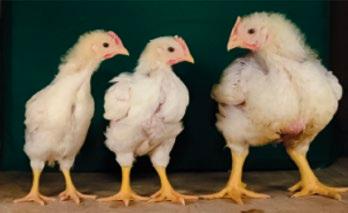
There are no legal regulations for rearing males.
Figure 1. From left to right, five-week-old chickens: Lohman Brown Plus chiken (brother of laying hen), Lohman Dual chiken (dual purpose-breed), and Ross 308 chicken (broiler) (Malchow, 2019).
Due to the low weight and carcass of these animals at slaughter, technical problems arise in slaughterhouses.
There is no demand for the meat because the males will not replace broiler breeds. Therefore, most males are grown in Poland and slaughtered with a low weight to be exported frozen to Africa. This practice increases the critics of NGOs.

i.e., male hatching eggs are sorted out before hatch, and only female chicks hatch.
About 15 methods worldwide for gender identification in the hatching egg, but only four are practicable in Europe. They differ in: the date of determination, the method of analysis, their marketability, and acceptance by consumers and NGOs.
Three different approaches can be distinguished:
Hyperspectral analysis can identify the gender of brown breeds on the unopened hatching egg on the 14th day of incubation from the growing feathers of the embryo. This process is already used in Europe.

Spectroscopy can determine the sex on the 4th-5th day of incubation through a hole in the eggshellbut it is not yet ready for the market.
There are further research projects on the analysis through the closed hatching egg on the 4th-5th day of incubation.
On the 4th day of incubation, the allantois bladder develops in the hatching egg, reaching its maximum size on the 9th day of embryo development.
The allantoic fluid can be analyzed by endocrinology, PCR, or MRI analysis to determine the gender of the hatching egg.
Various approaches using a molecular biology method called Clustered Regularly Interspaced Short Palindromic Repeats, better known as CRISPR.
It attempts to terminate the development of the male embryo early or even make it recognizable before incubation by fluorescent light, which is not well accepted in Europe.
This research is mainly taking place in Israel and Canada. The practical maturity of these processes is uncertain.
These are the advantages of gender identification in the hatching eggs:
This solution to end chick culling is the most cost-effective because males have no increased feeding needs.
It is the most sustainable solution because there is no waste of raw materials and because there is a circular use of nutrients since the male hatching eggs are used for feed production.
The CO₂ footprint of the table egg is lower with this solution than with raising the males of dual-purpose breeds or laying hens. The logistics of the supply chain are much more manageable.
The disadvantages of gender identification in the hatching eggs are:
It is not well accepted by more conservative groups who consider that the problem is only moved forward by culling embryos instead of one-day-old chicks.
There is considerable uncertainty about the beginning of the embryos pain perception.
The SELEGGT process was the first process of gender identification in the hatching egg in the world to offer its service to hatcheries starting in 2019.

It is a liquid-based process that determines the gender by analyzing the allantoic fluid via endocrinological analyses on the 9th day of incubation.
The process is divided into three parts:
On the ninth day of incubation, the candled hatching eggs enter the SELEGGT Circuit.
The first station is the detection of the egg’s blood vessels and measurement of the egg size and height, which determines the best place for the perforation.
Then a tiny hole of 0.3 mm is made by laser in the eggshell. A sample of a few drops of allantoic fluid is extracted by suction. After sampling, the hole is sealed with a beeswax seal; therefore, the risk of contamination is minimized.
Figure 2. Lasering the small hole in the eggshell.

The sample is sorted in its corresponding position on a microtiter plate. The microtiter plates with the samples are taken to the attached SELEGGT LAB.

An ELISA test and a patented marker measure the estrone sulfate level in the samples. A color change of the sample indicates a significant quantity of hormone, which determines that the embryo is female.
The tray with the sampled eggs advances on a conveyor belt to the SELEGGT SORTER. The machine sorts the hatching egg into male and female according to the results of the analyses. The female hatching eggs are returned to the incubator to continue the conventional incubation process. The male hatching eggs are discarded to be processed into high protein feed.

These are used as supplements in pet food, piglet feed, and aquaculture.
They, therefore, play a critical role in the circular approach to nutrient use.
The advantage of sealing the egg perforation with beeswax is that it is allowed as a feed ingredient, and its use does not present any drawbacks.
The technical data of the process are: 99% accuracy.
Able to analyze eggs of all colors and genetics.
The gender detection can be done as early as 9 days of incubation.
High-performance pipetting leads to a sampling time of one hatching egg per
Non-invasive method.
Compatibility with all setter trays (150/88).
Check out the videos of the process:
In Germany, there is a great debate about the possibility of embryo pain perception during the gender identification process in the egg.
Various scientific studies have confirmed that nociception, i.e., the embryo’s perception of stimuli, is possible from the 7th day of incubation onwards.

However, nociception is not sufficient for emotional pain perception. It is assumed that there is continuous development and that from the 15th day of incubation at the latest, there is a connection to the brain so that emotional pain can be perceived.
A new study by the Technical University of Munich, to be published in early 2023, will provide new findings on the development between days 7 to 15 of the incubation.
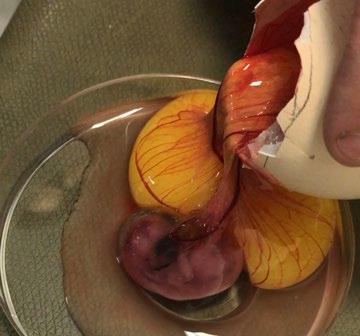
These results could be decisive for the implementation, delay, or even abolition of the second part of the German law that plans to ban all sexing methods after day 7 of incubation from January 2024 due to the possibility of pain perception.
It is essential to mention that today the earliest gender identification method is on day 9 of incubation.
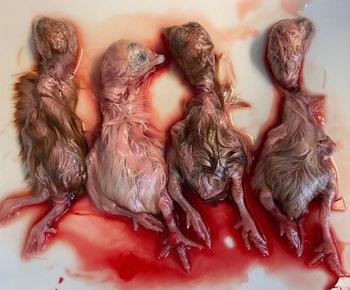 Figure 4. Day 9 of incubation, size of embryo 3cm.
Figure 5. Day 15 of incubation, size of embryo 15cm.
Figure 4. Day 9 of incubation, size of embryo 3cm.
Figure 5. Day 15 of incubation, size of embryo 15cm.
Ending chick culling has led to the following changes and challenges in the German poultry sector so far:
Laying hens are kept longer (up to 120 weeks) because ending chick culling has led to higher laying hen prices.
Laying hen genetic lines with a higher lifetime performance are preferred, especially the ones with a long production of medium and large eggs.
Table egg prices have risen by 2-4 Eurocents per egg.
Search for new market niches for the commercialization of brother layer meat.
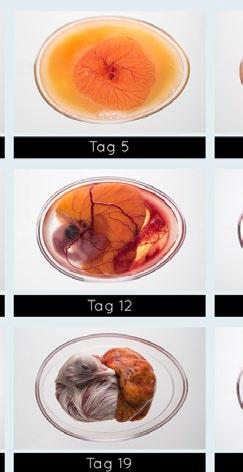
Need to promote a European law.

Germany, France, Italy, Switzerland, and Austria have already formulated legal conditions to end chick culling. So far, these have only been implemented in Germany. Other European countries have converted their supply chains to “Free of Chick Culling” (e.g., the Netherlands, Belgium).

There are considerable differences in the requirements of different governments to end chick culling. The main differences are:
The accepted hatching day to perform gender identification
The handling of mis-sexed male chick, The time validity of the laws
The preferences for the three solutions
Consumers and NGOs increasingly request animal welfare. The reasons for chick culling are not accepted anymore; therefore, the poultry sector is looking for alternatives.
Three solutions have already been implemented in the German poultry sector, and dual-purpose breeds and brother layer fattening have presented significant disadvantages compared to gender identification in the hatching egg.
Raising the males requires more extended grow-out periods to reach optimal live weight than broilers breed, and it is not economically rentable because of the high feed costs due to the lousy feed conversion.
Raising the males is unsustainable because of the waste of raw materials and the higher CO₂ production compared to gender identification in hatching eggs. Therefore, gender identification in the hatching eggs is becoming the most desired solution because it is the most cost-effective and sustainable solution to end chick culling in Europe.
Today, the SELEGGT process is the earliest process used in daily operation in hatcheries. However, the use of the 9th day of incubation is not without controversy, as there is uncertainty about the onset of a pain perception of the embryo. New studies should bring clarity in 2023.

Ending chick culling has led to far-reaching changes in the egg industry in Germany and other European countries. It shows that ending chick culling is challenging to implement at the national level when countries are not self-sufficient in egg production. An EU regulation banning chick culling would be the best solution for the industry and European fair competition.







Production systems that raise cagefree laying hens -which live loose in barns with or without access to an outdoor area- allow the birds to express natural behaviors in accordance with the animal welfare principles. These commercial-scale systems have expanded quickly in the last decade not only in Brazil, but also in Latin America, bringing new knowledge on this topic, challenges and breaking taboos.
Are birds more susceptible to fractures in cage-free systems?
Is productivity lower in these types of systems?
Is there a higher mortality rate with increasing cannibalism among birds?
Are there more pests and predators in these systems?
Is the quality and innocuousness of the eggs lower due to a greater contact with the droppings of the birds?
If the birds are healthy within a hygienically favorable environment and productivity rates are good, can that be considered animal welfare (even when using cages)?
In 2005, Dr. Rosangela Poletto joined the Certified Humane program as an animal welfare auditor for several animal species. And, since 2010, as a PhD in Farm Animal Behavior and Welfare, she keeps a close look at the commercial activity of cage-free eggs.

Arguments about mortality caused in cage free system by: fractures and bacterial or parasitic infections cannibalism
This study revealed that unlike what may be observed in conventional cage type systems bird mortality is reduced on average from 0.35% to 0.65% each year that producers acquire more

And over the last few years, there has been no difference in mortality rate between cage and cage-free type systems, contradicting the notion that a higher mortality rate is inherent to cage-free hen production.
It also reinforces the importance of considering how mature the system is in terms of the technical-practical knowledge of those involved in the production and their abilities to evaluate and manage all handling procedures, as well as the nutritional, health, and behavioral indicators that provide animal welfare.

eggs
Are raised by those who have yet to better evolve in their knowledge and practical learning in the management of laying hens reared in alternative systems.

In 2021, a study published by the renowned journal Scientific Reports analyzed data obtained from 6,040 flocks of hens (176 million birds) raised both in cage and cage-free type systems in 16 countries.
No production system can maintain good productivity and welfare levels without a strict biosecurity control.
Sanitary barriers and measures are typically used in conventional production systems, and, in the same manner, they must be adopted in cage free systems.
As practical evidence, all producers certified by the Certified Humane program must comply with the procedures listed above and several others to ensure not only the welfare of the birds, but also the microbiological quality of eggs and by-products purchased by consumers.
Proper litter maintenance is critical inside the barns, since:
When it is wet and in poor condition, it promotes the spreading of parasites and other pathogens.

It undermines the body thermoregulation of the birds in cold weather conditions and, It also causes dropping build-up around their toes that hinder their movement.
Nests with fresh litter or mats also ensure the sanitary quality and longer shelf life of the eggs.
Monitoring of salmonella in eggs is a basic procedure in any production system, and it is neither more nor less relevant when raising cage-free laying hens, since the absence of salmonella indicates the correct use of sanitary and biosecurity measures, among others.
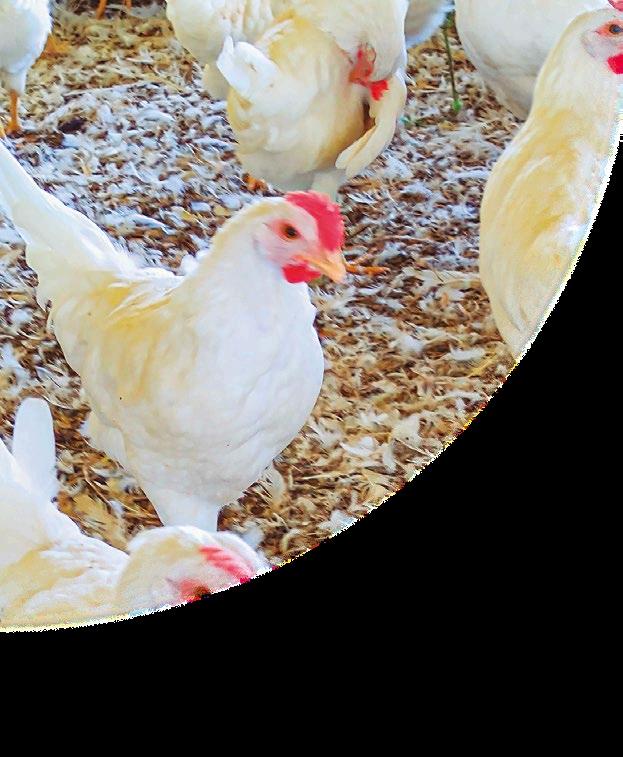
By adopting these actions, the incidence of pathologies -especially any infectious diseases- is very low in cage-free systems.
Another important factor that must be considered is the immunocompetence of cage-free birds. In other words, hens are more resistant to potential pathogen challenges or infections.
Housing options where birds can express their natural behaviors provide them with more neurophysiological “comfort” than frustration, and, as a result, blood cortisone levels are not as high and persistent.
Commonly known as the “stress hormone”, cortisone is an immunosuppressive that may linger in the system causing a reduction of the reproductive hormones.
Still, in any rearing system, some birds may become sick or deblitated for various reasons. However, in cage-free systems, those birds are easily detected and subsequently segregated when monitoring the nests boxes and during the required periodic barn inspections.

Hospital enclosures (preferably one per barn) -both in pullet and egg laying stages- make it possible for a greater number of sick and weak birds to recover.
These areas must have the same resources as the rest of the housing areas, which include perches for spent hens to escape from others and protect themselves.
Source: R. PolettoTherefore, birds that receive an adequate diet and are managed in an environment with low-pathogen pressure are much less susceptible to diseases.
Overall, producers indicated that the outcomes of these factors based on their practice are:

Fewer debilitated and sick hens;
Low mortality rate; and
Higher productivity, with prolonged laying peak.
Recording the movement of birds in the hospital enclosure, as well as the causes of segregation, is essential to detect relevant and recurrent health, nutritional or behavioral problems within the flock and promptly fix them.
R. Polettoeggs
Source:
R. PolettoAbnormal feather (and skin) pecking behavior, which can lead to cannibalism, is a constant challenge in laying hen production. The consequences of not making an early diagnosis are more severe in cage-free systems due to the obvious physical interaction of hundreds of birds in the same place, unlike systems with a cage with 10 to 12 hens.

Also, denying birds that are used to outdoor access areas can cause them stress and frustration. To prevent pecking and cannibalism, it is essential that the rearing system practice adopted is understood, paying close attention to the training of the caretakers and how hens are handled daily.
To identify any potential problem with the birds at an early stage, daily inspections of the barns, with an EYE ON THE HEN and not only to the eggs, are essential

As abnormal behavior persists and injuries increase, a more severe stage of cannibalism sets in and becomes more difficult and challenging to control.
This behavioral deviation is multifactorial and reflects stress factors that compromise the hens’ welfare and productivity. Therefore, feather pecking and cannibalism indicate, for instance, one or more of the following inappropriate practices:
Poor environmental management;
Nutritional deficiencies (quality and quantity);
Inappropriate equipment maintenance;
Or, even, resource competition.

Perches in cage-free systems not only support the hen’s natural perching behavior, but are also important in allowing pecked, submissive, and unproductive hens to escape from others and in helping the birds keep good physical condition
Understanding these factors breaks the taboo that cage-free laying hens suffer numerous leg bone fractures and keel deformation.
This may be a risk when relocating birds with fully developed bone structures from cages to barns where they have access to elevated / vertical surfaces such as slats or perches, or even nest boxes with a front perch.
However, this is not the correct management of the birds as it respects neither their physical nor the natural behavior of hens.
Perches or any vertical structure properly built for the bird and provided from the beginning of rearing (first weeks of life)
aid in developing the animal´s bone structure and progressive physical condition, acquiring resistance and muscle tone.
Chicks that are only a few days old use feeder and drinker lines to perch, especially when perches are not available.
From that moment on, they exercise and improve their movements when flying and landing on the litter or any other surface of the barn
So, the frequent use of perches gives cage-free hens the proper physical resistance and behavioral learning to not “fall” when they perch and fly in cage-free systems.
These systems, especially those that allow birds access to outdoor areas, require strict preventive and control management of endoparasites and ectoparasites. Laying hens are omnivores foraging and feeding on vegetation, insects, worms, and other small animals that can be hosts to parasites.




For these and other sanitary reasons, any constant accumulation of rainwater must be properly drained by fixing the ground inclination
The drainage of the water from the sink in the service area or from washing any footwear, for instance, should absolutely be avoided in the outdoor areas to help control the proliferation of flies.
Both caged birds and cage-free birds without outdoor access can be infested by ectoparasites such as lice. The installation and proper maintenance of protective netting against birds are important measures to prevent the entry of wild birds into the barns. Constant monitoring of the environment and the birds is required.

The broad knowledge we have about intensive poultry production, as well as about the physiological and behavioral needs of birds and the growing experience with new systems for laying hens rearing, must not allow us limiting ourselves to arguments that are not very well sustained. From a neurophysiological and behavioral point of view, it is impossible to associate welfare with caged hens based solely on biosecurity and productivity indicators.
Defending the thesis that hens raised in cage-free systems have high mortality and fracture rates or more health issues as to conventional system is questionable, and requires a critical and technical scientific analysis of the production context.
Therefore, everything must be considered in this specific context, from the qualification and competence of the managers and caretakers who handle the birds daily, to the inherent factors of the laying hen genetics and the model or rearing system implemented.

Promoting opportunities to share and consolidate “new” theoretical knowledge and management practices on cage-free systems is enriching for the entire sector. This discussion must go beyond market trends for sustainable products.

The current scientific knowledge on laying hen management in cage-free systems is in accordance with practical examples from small, medium, and large farms which have proven that the system is viable. There is no way back!























Source: R. Poletto

 Edgar O. Oviedo Rondón DVM, PhD., Dip. ACPV Professor/Extension Specialist
Edgar O. Oviedo Rondón DVM, PhD., Dip. ACPV Professor/Extension Specialist
The stomach in chickens is subdivided into two parts, the proventriculus (glandular stomach) and the ventriculus (gizzard). The proventriculus is the organ producing acid and enzymes. The gizzard is the muscular stomach and pacemaker of gut motility.
 Prestage Department of Poultry Science, North Carolina State University, Raleigh, NC 27695
Prestage Department of Poultry Science, North Carolina State University, Raleigh, NC 27695
They are pivotal for digestion and gut health. But, gizzard erosions are frequent according to reports of health surveys like the Poultry Health Insights HTSi* (Figure 1). Proventriculitis is also a common clinical finding, causing carcass condemnation when swollen proventriculi tear during evisceration.
Gizzard erosions reduce feed intake, affecting: growth and reducing digestion, increasing gut health issues, and worsening feed conversion ratio. Gizzard underdevelopment, dystrophy, and proventriculitis can affect hydrochloric acid and enzyme production and activity, causing: indigestion, increasing substrate for microorganisms in the hindgut, and starting dysbiosis gas production in the ceca, increasing passage rate, and causing microbial infections.
Average Lesion Score: Gizzard Erosions (2010-2012)
0.0 0.2 0.4 0.6 0.8 1.0 1.2
Gizzards and proventriculus can be a marker for broiler performance and health. It has been observed that 15 to 25% of the birds habitually necropsied in poultry farms show some proventriculus inflammation, gizzard erosions, or ulcerations. Once observed, it is important to know the factors that can cause them to start exploring solutions.
Average Lesion Score (0-3) Year Asia paci c Europe, Middle East, Africa Latin America North America
Region:
Figure 1. The average severity of broiler gizzard erosions observed in necropsies on four continents. Source: Poultry Health Insights HTSi*
To understand an abnormality or lesion in an organ, it is necessary to understand its anatomy (Figure 2) and the normal development as broilers grow.

Gizzard Proventriculus Oesophagus
health

Conical papillae
Keratinoid lining (hard) Submucosal glands Kereatinoid lining (soft) Mucosa and submucosa
Mucous epithelium
Smooth muscle
Figure 2. Anatomy of the gizzard. Source: Péter Lőw et al. 2016.
Atlas of Animal Anatomy and Histology.
*conducted globally by ELANCO Animal Health.
| Gizzard and proventriculus as a health marker
The proventriculus has a thick mucosa and submucosa occupied by glands (Figure 3) producing acid and digestive enzymes, whereas the gizzard is a grinder in the absence of teeth.
The mucosa of the gizzard is covered by a solid layer of a carbohydrateprotein complex called the koilin layer, also termed keratinoid lining (hard), cuticle, and gizzard lining.

Mucous epithelium
Muscle layer
The good development of the gizzard can be evaluated by the thickness and tone of its muscular development.
Lumen of proventriculus Glandular lumen with secretion
Figure 3. Cross-section slice of the chicken’s proventriculus wall (formalin-fixed specimen). Source: Péter Lőw et al. 2016. Atlas of Animal Anatomy and Histology.
Early in life, the gizzard and proventriculus have the most significant relative weights compared to other gastrointestinal organs. Figure 4 shows the relative weight (g/kg body weight) of the crop, proventriculus, gizzard, and pancreas from 1 to 35 days post-hatch in broilers fed ground wheat or whole wheat based diets.
In day-old chicks (45 grams body weight), gizzard+proventriculus can weigh 2.9 grams. Gizzard development can be affected by: the particle size of the feed, the type of fiber, and the presence of grit or litter material.


In Figure 4, Ravindran et al. (2006) represented the significant differences in relative gastrointestinal weights due to wheat form. In gizzards, the differences were observed on days 21, 28, and 35.
Better gizzard development is related to higher feed efficiency and better feed conversions. In Figure 5, the blue color indicates a better feed efficiency group of broilers, and notice the higher development of the gizzard (Fig 5A) at 14 and 50 days and the smaller relative size and lower variability of the jejunum (Fig 5C) and ileum (Fig 5D) in the highefficiency chickens. In red boxes, variable size and larger intestines indicate lower feed efficiency, higher proliferation of microorganisms, more gut inflammation, and potentially more health and food safety issues.
Relative weight (g/kg BW)
10.0 Crop
8.0
6.0
4.0
Clostridium perfringens have been isolated from broiler gizzards with erosions and ulcers, and the caecal counts also increase. C. perfringens is considered an opportunistic pathogen involved in these lesions.
25.0 35.0 45.0 55.0
15.0
Feed additives like narasin that control C. perfringens and increase insoluble dietary fiber reduce the severity of gizzard erosions and ulcers.
Relative weight (g/kg BW)
4.0 6.0 8.0 10.0 12.0
6.0
4.0
2.0
0 7 14 21 28 35
Age (day)
health
0 7 14 21 28 35 Age (day)
2.0 5.0 2.0 0.0 0 7 14 21 28 35
0 7 14 21 28 35 Age (day) Age (day)
Figure 4. Relative weight (g/kg body weight) of the crop, proventriculus, gizzard, and pancreas from 1 to 35 days posthatch in broilers fed ground wheat- or whole wheat based diets. Source: Ravindran et al., 2006.
proventriculus
0.06 Gizzard weight/ body weight ratio
Jejunum weight/ body weight ratio
0.02 D0
Gizzard
p= 0.90 p=0.81 p=0.025 p=0.21 p=0.42 p=0.047
B Duodenum
C D
0.04
0.03
p=0.95 D07 D07 D14 D23 D35 D50
D14 D23 D35 D50
Jejunum

p=8,10.106 p=0.00025 p=7,67.104 p=0.54
Duodenum weight/ body weight ratio Ileum weight/ body weight ratio p=0.064
0.020
0.04 0.02 0.01 0.01 0.010
0.025 0.02
p=0.23 p=0.99 p=0.0077 p=0.22 p=0.027
0.015
Stage Stage Stage Stage
p=0.26 p=0.00061 p=0.013 p=0.11
Ileum
D07 D14 D23 D35 D50 D07 D14 D23 D35 D50
Figure 5. Allometric growth of the digestive tract during development (organ weight/body weight) of gizzard (A), duodenum (B), jejunum (C), and ileum (D). Box colors indicate broiler efficiency, blue for high and green for low. Source: Juanchich et al., 2012.
Lesions in the gizzard and proventriculus can be caused by multiple factors present before hatch and during grow-out. Farm factors include: starvation, feed structure and fiber, feed particle size, nutritional deficiencies, toxic substances, viral infections, and microbial colonization. In Pre-hatch factors, mycotoxins, viruses, and incubation may play a role. Breeder feed can be contaminated with multiple mycotoxins.
Wang et al., 2021. FB1 24 µg +DON0.1 µg +DON 0.1 µg +FB2 2.4 µg +FB2 4.8 µg +DON 0.1 µg +FB3 2.4 µg +FB3 4.8 µg

group
Several research groups have isolated fowl adenovirus serotype A (FAdV-1) from gizzard erosions and ulcerations in laying hens (Lim et al., 2012; Matczuk et al., 2017), and the same FAdV-1 has been proven to reproduce the outbreak of gizzard erosions in broilers (Grafl et al., 2013; Schade et al., 2013; Mizazadeh et al., 2019). Vertical transmission has been confirmed. FB1 24 µg FB1 48 µg FB1 12 µg FB1 3 µg FB1 7.2 µg FB1 14.4 µg FB1 12 µg

group +FB2 1.2 µg +FB3 1.2 µg 41
group health aviNews International September 2022 | Gizzard and proventriculus as a health marker
group
Grafl et al. (2012) reported the isolation of genetically identical FAdV-1 strains from gizzards of embryos at the lowest point of hatchability and affected broiler flocks raised on independent farms.
These authors demonstrated direct detection of viable FAdV-1 from gizzards of embryos and progenies of one FAdV-1-seropositive broiler breeder farm during an outbreak of adenoviral gizzard erosion.
Though, others have detected the virus in gizzard lesions (Figure 6) but failed to establish vertical transmission (Lindgren et al., 2022).
Figure 7. Gross lesions in gizzard from 19- day-old broiler chicken associated with fowl adenovirus serotype 1 (FAdV01). Erosions, detachment of the koilin layer, and dark discoloration indicate bleeding. Source: Lindgren et al., 2022.
Additionally, to the adenovirus, some lesions caused by the particular virus are reflected in the gizzard proventriculus area.
However, it is essential to consider that this FAdV-1 also causes gross and histological lesions in the thymus, bursa, liver, pancreas, and kidneys. This FAdV-1 infection not only affects the gizzard.

The infectious bursal disease virus (IBDV) or Gumboro disease can cause hemorrhages in the union between proventriculus and gizzard and proventriculitis. Control of IBDV seems to reduce the incidence of proventriculitis.
However, the gizzard is the site where virus detection can be more common and persistent (Steer et al., 2015).
The velogenic strains of Newcastle can cause hemorrhages in the proventriculus and the whole gastrointestinal tract. Other viremias like the avian influenza virus can eventually cause similar lesions.
Proventriculitis has been observed in cases of infection with the Marek disease virus and, together with IBDV, can cause immunosuppression. The reovirus causing the “malabsorption syndrome” also causes proventriculitis.
ulcerated gizzard increases, starvation also increases gizzard erosions in broilers at 1, 2, 4, and 8 weeks of age.

Heat stress in the hatcher and at the farms can increase similar lesions. However, these effects are usually temporary, and starvation should be considered only a predisposing factor.


A proventricular necrosis virus member of the Birnaviridae family has been observed to cause transmissible viral proventriculitis in chickens (Śmiałek et al., 2020). Then, proventriculitis can be a sign of viral infection.
Starvation causes regurgitation of bile to the gizzard, which can be protective but also a marker of a management issue (Figure 8).
All research indicates that coarse feed particles stimulate gizzard development and improve its health, reducing potential erosions and ulcers.

Fiber can also reduce the pH of gizzard contents due to a buffering effect that some fiber components may have.
Non-soluble fiber and grit seem to exert effects similar to particle size.
Fine feed particle size reduces the muscular development and size of the gizzard and causes hypertrophy of the proventriculus and guts.
In all cases with proventriculitis and gizzard erosions and ulcerations, the feed particle size and its variability among batches of feed or feed phases should be evaluated.
At levels above 250 ppm fed for several weeks, copper sulfate can cause: gizzard erosions, proventriculitis, and gizzard distention.
Trichothecenes like DON, T-2, HT2, diacetoxyscirpenol (DAS) or monoacetoxyscirpenol (MAS), and nivalenol produced by Fusarium fungi have been reported to cause gizzard erosions in broilers. However, very high concentrations of DON (49.4 and 83 mg/kg feed) are needed to observe these lesions. Fumonisins B₁ and B₂, moliniformin, oosporein, rubratoxin, and cyclopiazonic acid (CPA) at 50 to 100 pm are other mycotoxins linked to gizzard ulcers.
The combination of several mycotoxins can be more harmful than individual mycotoxins that seldom reach levels high enough to cause these lesions in commercial feed.
These substances are produced by microbial degradation of amino acids. The most well-known is histamine produced from the amino acid histidine in fish products. Histamine can cause severe gizzard erosions and “black vomit.”

The product called gizzerosine produced when the fish meal is overheated (>130oC) can cause lesions when feed concentration reaches 0.15 mg/kg.
Vitamin E prevented gizzard ulcers under conditions of: high levels of polyunsaturated fatty acids, high dietary levels of cod liver oil (510%), menhaden oil (0.5 to 1%), and fish meal (15%). These inclusion levels of fish byproducts are not standard in poultry diets and can hardly have practical implications.
However, in the USA and most parts of the world, poultry diets seldom contain fish meals at inclusion levels considered necessary to cause this pathology.
The deficiency of vitamin B₆, which is also not very common, could reduce the production of taurine and taurocholic acid, which makes part of the bile. Lack of bile can increase gizzard erosions and eventually ulcers.
health
Gizzard erosions and ulcers, and proventriculitis are gut health markers. Several factors can cause these lesions. The most common could be fine feed particle size or low nonsoluble fiber and mycotoxins. Viruses like the fowl adenovirus serotype A (FAdV-1), IBDV, and the transmissible proventricular necrosis virus can be implicated. Careful differential diagnostics should be conducted to determine factors to control the cause of these signs of management and health issues.
Gizzard and proventriculus as a health marker
DOWNLOAD THE PDF
References available upon request
| Gizzard and proventriculus as a health marker


The great diversity exhibited by Salmonella spp (S.) is one of the most critical characteristics that must be considered for its control. While it is true that more than 1,500 serotypes are now included in subspecies enterica, it has been postulated that perhaps 100 are actually important to public or animal health.
However, these relatively few serotypes present a high challenge for controlling this bacterium in poultry production since there is significant variation in their importance depending on the country, the region, and even the particularities of each company.
Martha Pulido Landinez, DVM, MS, PhD, DACPV. Associate Clinical Professor. Poultry Diagnosis and Research Laboratory (PRDL). College of Veterinary Medicine, Mississippi State University.Serotyping of a Salmonella spp isolates frequently yields results related to a serotype with a “rare” name, which had not been previously identified, and which is challenging to identify again later. But, then, it practically disappears without leaving a trace! This is not the case for S. infantis, which has come to poultry production to stay.
The genus Salmonella belongs to the Enterobacteriacea family, It has two species (Salmonella enterica and Salmonella bongori). In turn, the enteric species is subdivided into 6 subspecies. The enterica subspecies, which includes 1,586 serotypes, is the most important related to public and animal health.

!The diversity of the enterica subspecies makes it difficult to diagnose and establish effective control measures.
The presence of S. Infantis implies a high risk to public health and, occasionally, to birds’ health.
In several countries in Europe and Latin America and some regions in the United States, the frequency of isolation of this serotype from poultry products, especially from chicken and turkey meat and their by-products, are becoming more frequent.
Several foodborne illness outbreaks and high antimicrobial resistance (AMR) exhibited by S. Infantis have made this bacterium a major concern (CDC. 2018).
There are many differences between serotypes, both from the point of view of pathogenicity for humans and animals and their adaptation to poultry environments.
Identifying the predominant Salmonella spp serotype in a farm is essential to achieving its control.
Knowing which are the preponderant serotypes, important decisions are made that imply, for example, the adoption of vaccination plans.
On the other hand, when a Salmonella spp monitoring program is carried out with sustained frequency, the so-called emerging serotypes may also be identified.
Emerging serotypes are exotic to a region or country, have previously occurred, and are considered eradicated but are re-diagnosed. They are also those that present variants that are not easily identified.
In most cases, these serotypes are of low prevalence, usually do not cause disease in birds, or may be associated with minor signs and lesions and, for this reason, go unnoticed.
Often, they are not detected due to poor or limited diagnostic techniques; this is common when the diagnosis is based solely on the determination of “presen ce-absence” of Salmonella spp (Pulido-Landínez, 2015).
Several cases of emerging serotypes can become persistent when they better adapt to birds and their environment (Pulido-Landínez, 2018). Some serotypes are more resistant than others to various conditions seen in poultry facilities.
While some serotypes may be considered temporary or transient, others can persist in the environment, adapt to birds, and become fully established in poultry environments.
These are the resident serotypes that can multiply, creating true bacterial communities, persist for a long time, even after cleaning and disinfection processes, and are often related to decontamination (Table 1).
For this reason, understanding the concept of “transient serotypes vs. resident serotypes” and why their early detection is important are key elements for implementing a successful Salmonella spp control plan.

They are occasionally isolated and identified.
Many are not pathogenic (neither to humans nor to birds).
Important in terms of RAM.
They are usually “weak.” They can be removed with routine cleaning and disinfection processes.
They must be identified and prevented from adapting to birds and poultry environments.
They can be fully adapted to both poultry and poultry environments.
They can adapt to pests, multiplying inside them.
Important in terms of RAM.
They multiply exponentially.
They persist for long periods.
They are present in consecutive flocks.
Routine cleaning and disinfection processes do not remove them.
They can cause constant re-contamination.
Table 1: Differences and similarities between transient and resident serotypes.
Although the presence of any serotype of Salmonella spp can indeed be a major problem for the poultry industry, the worst scenario occurs when serotypes of great importance for public health, such as Enteritidis and Typhimurium, persist in poultry integrations.
However, it is now known that serotypes such as Kentucky, Heidelberg, and especially, Infantis can easily become resident serotypes and have become a problem in several countries. (Figure 1)
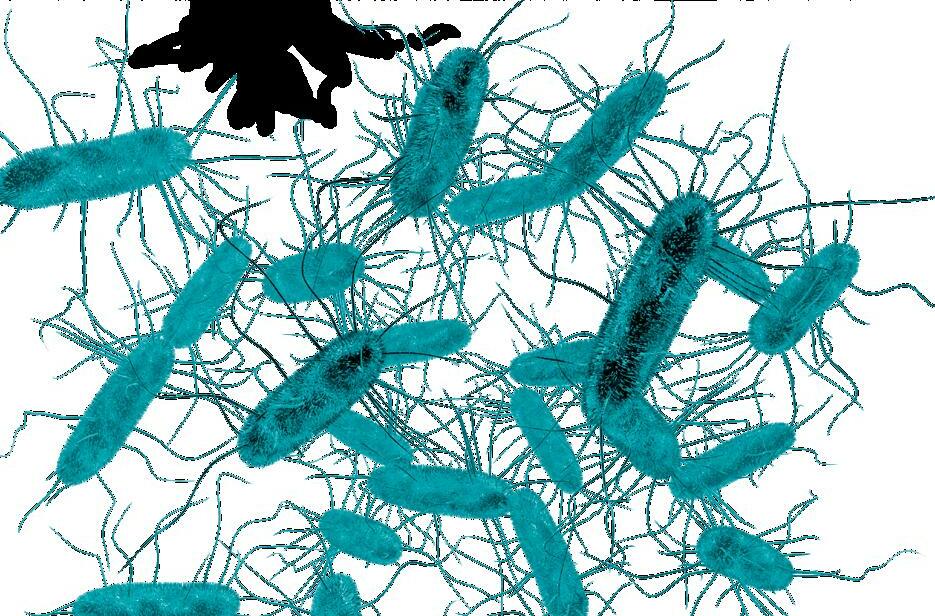


Figure 1.
Not only because they can cause foodborne illness but also because they can often be multi-resistant to antibiotics.
On the other hand, this serotype has been identified as a secondary agent capable of causing disease and high mortality in broilers (Pulido-Landínez, 2019), Figure 2.




Chicks aged 21-28 days have air sacculitis, pericarditis, and perihepatitis.
Figure 2.

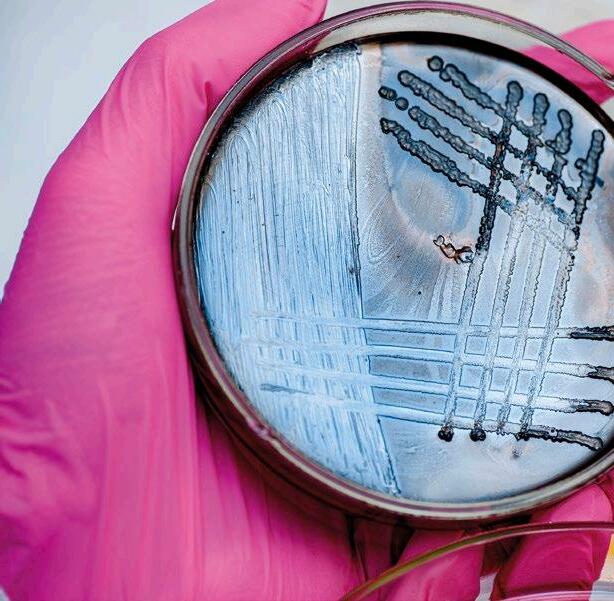
Much has been studied to understand the mechanisms used by Salmonella spp to adapt to birds and their environment very efficiently.
Recent studies have shown that the serotype Infantis has some characteristics similar to S. Enteritidis and S. Typhimurium.
However, some of its clones seem to have unique characteristics that make them more adaptable.
Today it is clear that the survival ability of Salmonella spp may be serotype dependent and that the survival period is influenced by various factors such as temperature, humidity, and the characteristics of the organic matter present, among others.
The so-called mobile genetic elements can be found in the genome of Salmonella spp. Among these are plasmids and transposons.
These elements that can be shared between bacteria (conjugation) contain different genes that can be related to AMR, the virulence of the bacteria, and its adaptation to birds and poultry environments.
Plasmid conjugation plays a preponderant role in microbial evolution, allowing the acquisition and exchange of new genes that confer new phenotypic characteristics to the recipient bacteria.
Identifying the different mechanisms that bacteria use to achieve their adaptation and understanding how they work can contribute to the control of specific serotypes.
Below
1S. Infantis has effective systems for adhering to intestinal cells.

Similar to serotypes Enteritidis and Typhimurium, S. Infantis can adhere to intestinal epithelial cells and then invade.

Once S. Infantis adheres to the intestinal epithelium, it enters the cell and uses different mechanisms to replicate and invade the host. Hence the importance of using tools that prevent this initial adherence.
Recent studies carried out on S. Infantis isolated from chicken meat in Chile have shown the presence of virulence genes sipA, sipD, and sopD, which facilitate the entry of this bacterium into the host cell through the formation of “membranes” and alteration of actin structure (Lapierre et al, 2020).
The characterization of S. Infantis from chicken meat in Italy by Franco et al. (2015) showed that the emerging Italian clone has genes encoding factors associated with greater colonization capacity and virulence, along with those genes related to antimicrobial resistance and greater ability to survive in intensive production environments.
Similar results have been observed in isolates of S. Infantis from South American countries (Sanchez-Ingunza and Pulido-Lan dinez, 2020).
2S. Infantis can interact with the resident microbiota of the gastrointestinal tract and the environment.
Studies carried out in Israel by Aviv et al., (2016) showed that S. Infantis contains a unique megaplasmid (pESI) that confers resistance to multiple drugs and increases the presence of phenotypes of greater virulence.
are some mechanisms that could be contributing to the successful consolidation of S. Infantis in poultry production:
The ecology, transmission properties, and regulation of this particular plasmid are similar to that present in domestic bird populations in other countries (Franco et al., 2015).
The conjugation and transcription of this megaplasmid are very active from 37°C to 41°C in oxidative stress, moderate osmolarity, and under the microaerobic conditions that characterize the intestinal environment of birds.
The study by Aviv et al. demonstrated that after S. Infantis infection, the megaplasmid could be transferred horizontally to the microbiota present in the intestine, including S. Typhimurium and commensal strains of Escherichia coli.


These findings highlight the ability of S. infantis to distribute to and from the gut microbiota.
It also suggests an important role for intestinal bacteria as a reservoir of mobile genetic elements and as intermediaries in spreading antibiotic resistance and virulence genes between commensal and pathogenic bacteria.
Thus, by exchanging these elements, S. Infantis can acquire and propagate genes that allow it to adapt better to the intestinal environment or the poultry house.
Modulating the microbiota in the intestine and the environment can play a significant role in effectively controlling S. Infantis and its AMR.
Salmonella Infantis: an emerging serotype that has become a resident?

G. Talegón1, L. Aguirre1, H. Kadardar1, M. Frikha2, J.C. Abad2 y G.G. Mateos1
1Polytechnic University of Madrid 2Cobb Spain, Madrid
Using whole wheat as a supplement to commercial feed is not a new concept. It has been a common practice in Northern Europe for more than 30 years (Forbes and Covasa, 1995; Engberg et al., 2004). Compound unpigmented feeds for broilers contain approximately 50-60% wheat.
whole wheat
broiler feed: advantages
Grinding and granulation, together with transport, represent a high energy cost to manufacture a ton of feed.
Hence, the high use of whole wheat in countries like Denmark, where farmers plant the grain and raise chickens simultaneously.
In Spain, the main reason for including whole wheat in the feed was to control the problem of wet litter due to its effects on intestinal health and the functioning of the gastrointestinal tract (GIT) (Ravindran et al., 2006; Husveth et al., 2015).
The inclusion of whole wheat improves the functioning of the gizzard and reduces the incidence of proventriculitis, so, despite the high cost, its practical use increases.
In recent years, as a result of the ban on the use of antibiotics as preventives in the EU, the use of whole wheat has been extended to reduce the problem of wet litter and its impact on carcass quality.
In this particular, it has been shown that coarse grindings facilitate the functioning of the digestive system, improving the health status of the GIT of birds (Jiménez-Moreno et al., 2019).
To understand that whole wheat, at a physiological level, corresponds to the use of very coarse grindings; therefore, the physiological mechanisms that explain its activity are similar.
Recent data on the benefit of whole wheat on economic performance is conflicting.
To ensure success, feeding based on the inclusion of whole wheat should be started no earlier than 7 days of age with levels below 5-8%.
In the finishing phase, levels of around 4-5%, are recommended, taking into account possible problems in the slaughterhouse (contamination of the carcass and hours of fasting).


The beneficial effects of the coarse grinding of the ingredients (and therefore of the whole wheat) are related to the improvements in the functioning of the GIT and, in particular of the gizzard, where it improves the functioning with an increase in size and a reduction in pH which benefits the activity of pepsin and enzymes.
A functional gizzard increases the intensity of antiperistaltic movements, improving the motility of the walls and the integrity of the digestive mucosa (Svihus et al., 2004, 2010; Mateos et al., 2012; Jiménez Moreno et al., 2019)
Therefore, the positive effect of whole wheat will be more significant when there are digestive problems.
Recent research shows that the inclusion of whole wheat influences the control and prevention of specific processes and pathogenic microorganisms such as Salmonella, Clostridium, and coccidiosis. For example, Engberg et al. 2 (2004) found that whole wheat reduced the number of Enterobacteriaceae and Clostridium perfringens in broilers.
There are several criteria for using whole wheat in food:
AIn the most daring criterion, whole wheat is included at moderate to high levels (between 10 to 20% in the withdrawal feed) in substitution for commercial feed.
The great advantage of this strategy is the reduction in the cost per ton of feed and the increase in the factory’s production capacity.
The most significant drawback is that dilution (top dressing) modifies the nutritional profile of feeds, which can be a problem when high levels of whole wheat are used in commercial feeds with low safety margins.
In addition, with a high level of whole wheat for long periods of the bird’s life, we run the risk of a higher incidence of subclinical coccidiosis as a consequence of reducing the doses of coccidiostat below what is recommended.

A second criterion for use, probably the most widely used in practice, consists of substituting a percentage of the wheat in the conventional diet (incorporated into the pellet or in the mash, where appropriate) for whole wheat.


In this case, the nutritional value of the feed is not diluted, but the economic savings are limited to the lower energy costs in its manufacture (milling and granulation).
In both cases, when adding whole wheat separately from the feed, it should be considered that the whole wheat does not undergo any heating process and, therefore, there is a possibility of microbiological contamination.

On the other hand, the inclusion of whole wheat modifies the texture and palatability of the feed, which can lead to preferences for the compound feed or the whole grain by the bird.
This preference can vary from farm to farm with 2 key factors to consider: chicken age and presentation (mash vs. crumble) and particle size (fine vs. coarse).

In this particular, take into account that the young chick (6 to 8 days of life):
Tends to reject eating whole wheat as grain size does not match beak size.
The wheat remains longer in the gizzard than the mash. Therefore, it tends to accumulate in this organ, and the birds tend to reduce their consumption since their appetite is reduced due to “feeling full.”
Also, excess wheat in the gizzard slows down the speed of transit of whole wheat.
To avoid problems with full digestive systems and possible contamination in the processing plant due to the use of whole wheat, the withdrawal time of the poultry feed before transport must be considered.
A third system to include whole wheat in the feed consists of adding it in a mixer together with the rest of the ingredients already ground to make the compound feed.

Once mixed, it is passed through the granulator, obtaining a granule of medium quality (whole grain impairs the quality of the granule, but wheat “per se” tends to improve it).
The biggest drawback of this system is that the savings in the cost of manufacturing the feed are minimal, but on the contrary, the needs of the bird are better respected.
Therefore, including whole wheat in the chicken feeding program allows for many variations, depending on the farm type and management, which can lead to contradictory results.

In this particular, the effects are usually less advantageous and even detrimental in relation to feeding consumption. When wheat is offered free choice, there is no sequential phase of learning before consumption with changes in the texture of the feed offered and in the palatability and lack of some nutrients in the case of adding wheat to larger ones.

In a recent study carried out by our group at the Polytechnic University of Madrid, we studied the effect of the inclusion of whole wheat at 3 levels (control without added wheat and experimental with 3% wheat from 0 to 14 days and then 7.5 o 15% from 14 to 40 d of age depending on treatment) in Cobb 500 chickens fed two nutrient levels (medium and high).
The average levels corresponded to typical feed used in Spain at that time (2,900 to 3,100 Kcal/kg and 1.22 to 0.97% dig. Lys, depending on age).
While high levels correspond to feed with 100 Kcal AMEn/kg and 5% extra digestible Lys in each of the 3 experimental phases (0 to 14 days, 15 to 29 days, and 30 days to slaughter at 40 days of age).
A total of 540 day-old chicks were used.
Each treatment was replicated 6 times, and the experimental unit was the pen with 15 chicks each.
The experiment was completely randomized with 5 treatments sorted in a factorial way with feed quality (high vs. medium nutrient density).
and the level of use of whole wheat in direct substitution of pelleted commercial feed (control, medium, and high) as main effects.
The productive data at each change of feed and data on the development of the proventriculus and the gizzard at slaughter were controlled.
The performance data from 0 to 40 days of age and the development of the gizzard at 40 days of age are detailed in Tables 1 and 2, respectively.
Table 1. Influence of the type of diet and the use of whole wheat on the live performance in chickens from 0 to 40 days of age1

Avg. daily feed intake (g/d) Avg. daily gain (g/d) FCR (kg/kg) FCR (kcal/g BW)
Feed density

High 124 82.7 1.503 4.729 Low 127 80.6 1.573 4.711
Whole wheat level Control 124 83.6a 1.486a 4.545a Medium 125 81.9ab 1.522a 4.684b Low 128 79.5b 1.606b 4.930c DE (n = 6)2 4.33 3.24 0.037 0.118 P value
a–c Means from the same column that do not share a common superscript differ (P < 0.05). 1 Initial live weight 46.7 ± 0.80 g. 2 n = 18 diet; n = 12 inclusion of wheat. 3 Interactions were not significant (P >0.05).
Table 2. Influence of the diet type and whole wheat use on the development of the proventriculus and the gizzard at 40 days of age.
Feed density 0.106 0.060 <.001 0.638 Wheat 0.132 0.014 <.001 <.001 ABSOLUTE (G) RELATIVE (% BW) GIZZARD pH
Feed density
High 41.5 1.18 2.71 Low 37.5 1.10 2.76
Whole wheat level Control 37.1 1.04a 3.09a Medium 40.7 1.16ab 2.54b Low 40.8 1.21b 2.57bc DE (n = 6)1 5.55 0.141 0.453 P - value
Feed density 0.035 0.076 0.762 Whole wheat 0.201 0.018 0.009
a-b Means from the same column that do not share a common superscript differ (P < 0.05). 1n = 18 diet; n = 12 inclusion of wheat 2 Interactions were not significant (P >0.05).
From 0 to 40 d of age, the quality of the experimental feed did not affect the birds’ average daily feed intake (ADFI) (124 vs. 127 g/d). Still, the chickens that consumed the high nutrient density feeds grew more (82.7 vs. 80,6 g/d) and had a better FCR (1.503 vs. 1.573) than control chickens.
However, the energy FCR (Kcal AMEn/kg) was similar for both groups (4.73 vs. 4.71).

The inclusion of whole wheat in the feeding program did not significantly affect feed intake (124, 125, and 128 g/d for control, medium, and high percentage of whole wheat, respectively).
However, the ADG (83.6, 81.9, and 79.5 g/d) and FCR (1.486, 1.522, and 1.606) worsened with the use of wheat, specifically with the higher dose (15% vs. 7, 5% vs. 0%). Likewise, the energy FCR worsened with the use of whole wheat (4.55, 4.68, and 4.93).
The use of whole wheat increased empty gizzard weight in absolute (37.1, 40.7 and 40.8 g) and relative (1.04, 1.16, and 1.21%) terms, with significant effects (P < 0.05) were detected when comparing the control group vs. the mean of the 2 groups that included whole wheat (37.1 vs. 40.7 g and 1.04 vs. 1.19%, respectively).
Likewise, the pH of the gizzard was significantly reduced (3.09 vs. 2.55). The data shows that, under the indicated experimental conditions, with extraordinary growth of the chickens (3.35 kg in Cobb chickens fed with feeds of high nutritional density, without whole wheat), the use of whole wheat as a commercial feed diluent did not provide some productive benefit. Still, it improves the development of the gizzard and reduces its pH.
Including whole wheat in feeding programs reduces costs and generally improves bird productivity. However, the use of whole wheat in broiler feeding programs should not be considered, in the case of Spain, as an economic strategy but rather to improve digestive physiology to enhance productivity and, therefore, carcass quality.

The use of whole wheat makes more sense in situations of high incidences of digestive problems, on chicken farmers who are also cereal producers, and when feeds with wide safety margins are used.
The main problem of the use of whole wheat is related to the reduction of consumption, more frequent in farms with healthy birds, high levels of wheat without prior learning by the chicken, and the use of wheat as a diluent, which affects the nutritional profile of the feed. Use of whole wheat in broiler feed: advantages and disadvantages DOWNLOAD PDF
A popular belief used to explain why mycotoxins are not identified in significant concentrations in feed analyzes performed in clinical cases where lesions are compatible with mycotoxicosis, is that these lesions are caused by mycotoxins’ accumulation in several organs for long periods of time.

This concept is not necessarily correct because for decades, in scientific studies carried out in different research centers worldwide, it has been determined that the degree of accumulation and elimination of mycotoxins in the specific organs that they mostly affect, known as target organs, is relatively short.
In muscle tissues and body waste such as urine and feces, elimination is relatively rapid.
In other words, the mycotoxins with the highest incidence in commercial broilers and layers cannot be stored for long periods.

The continuous exposure to average levels of mycotoxins found in commercial feed, explains the presence of lesions and symptoms associated with mycotoxicosis cases in the field. This concept is widely accepted in the European Union, where many scientific trials are performed adding low levels of mycotoxins that produce deleterious effect in performance and target organs.
Fortunately, from a public health perspective, the poultry meat consumed by humans have a low concentration of mycotoxins and its metabolites, as has been demonstrated in several scientific reports published by several academic institutions.
Higher levels of mycotoxins and its metabolites will be present in liver, kidneys, and eggs than in meat. One of the characteristics of the mycotoxins that we will review below is that the concentration of residues in liver and kidneys are transitory and low, when compared to the concentration added to the rations during these experiments.
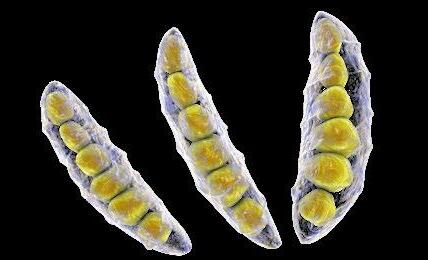

TYPE A TYPE B
T2 toxin, diacetoxyscirpenol (DAS)
Monoacetoxiscirpenol (MAS)
It is metabolized in the liver and excreted approximately 48 hours after ingestion as metabolites, mainly through the bile and feces.
A small amount is excreted through the eggs and detected in the yolk and albumen
Nivalenol
Vomitoxin (DON)
Others
Vomitoxin is rapidly eliminated in the feces
They are transmitted to the eggs in the
HT2, a metabolite of T2 toxins is produced in the field, before grains are harvested.
In a scientific trial, DON was marked with radioactive carbon (C 14) and given to several hens by a single oral application (intubation) or by spreading it over the feed for 5 days. The level of the mycotoxin elimination was determined by measuring traces of radioactivity in tissues and feces. DON absorption was very low, and the highest level found in plasma occurred 2 to 2.5 hours after ingestion and represented less than 1% of the original oral dose supplied, indicating that low level of intestinal absorption was achieved in the experiment. The maximum levels detected in fat, muscles and oviduct occurred 6 hours after application.

In birds, the absorption of FUMs through the gastrointestinal tract after ingestion of contaminated feed is very low, as a consequence of the low permeability of the intestinal mucosa to these toxins.
The organs most likely to show low detectable concentrations of FUMs are the liver, kidneys, and intestines. Detectable levels in skeletal muscle are also low.
After 24 hours, detecting traces in the mentioned tissues is difficult.

There are dozens of FUM metabolites, including A1, A2, B1, B2, B3, and B4.
Laboratory tests such as liquid chromatography with mass spectrometry (LC-MS) reported B1, B2, and B3 since this technique can detect several metabolites simultaneously.
Generally, FB1, produced by Fusarium moniliforme, is the most predominant under commercial conditions, but other fungi of the genus Fusarium can also produce it.
Based on animal studies, it has been classified as probably carcinogenic to humans.

Despite the rapid elimination of FUMs from the body, its continuous ingestion through feed will allow blood levels to remain stable and affect various organs depending on the animal species.
The metabolization is carried out by the liver, and the elimination occurs through urine, feces, and bile.
In the liver, intoxication produces an accumulation of sphingosine and sphinganine because the molecular structures of FUMs are similar to sphinganine and sphingosine, responsible for forming sphingolipid complexes (sphingomyelin and glycosphingolipids) in

They include a group of secondary metabolites that naturally contaminate grains and feeds. The most common are B1, G1, B2, and G2. In addition, M1 and M2 are also detected in birds’ urine and mammal’s milk.
The detection of M1 in milk produced for human consumption has been used for decades as an important marker of milk contamination.
B1, B2, G1, G2, and M1 are detected in the LCMS test.
All of these Aflatoxins are considered highly toxic and carcinogenic.
B1 is the most toxic form and primarily affects the liver. Many of these metabolites are concentrated in the gizzard, liver, and kidneys and are excreted through bile, urine, and feces within four days.
B1 is metabolized into conjugated forms in the liver and subsequently reduced to Aflatoxicol.
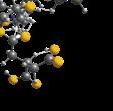
the intestinal villi and intestines.
The B1 and Aflatoxicol are detected in the ovaries and eggs for at least 7 days.
B1 can be accumulated in reproductive organs, allowing it to be transferred to the egg yolk and albumin with detectable residues in the yolk sac and liver of the progeny.
Ochratoxin A is distributed mainly in the Kidneys and, to a lesser extent, in the liver and muscles. It is rapidly eliminated in about 4 hours. In addition to the kidneys and liver, bile is used to detect waste. The presence of residues in the Kidneys can appear in the absence of lesions and persist for up to four days once the contaminated diet is removed.
Ochratoxin A is distributed in eggs after hens are offered contaminated feed for 3 to 5 days and disappears 5 to 6 days after removing the contamination source.

Zearalenone
The ZEA and zearalenol occur naturally in grains with zearalenol being more estrogenically active.


The metabolites of this mycotoxin are mainly detected in the liver and gallbladder. Through the feces, they are eliminated in the form of ZEA and zearalenol.
Chickens and hens tolerate it better than turkeys susceptible commercial birds). Residues in eggs are concentrated in the yolk, which are minimal and difficult to detect.
In conclusion, the accumulation and elimination of the mycotoxins mentioned in this article are considered the most important in commercial animal production, and occurs in a few days. This means that for sustained damage to occur, birds need to ingest these toxins for extended periods.

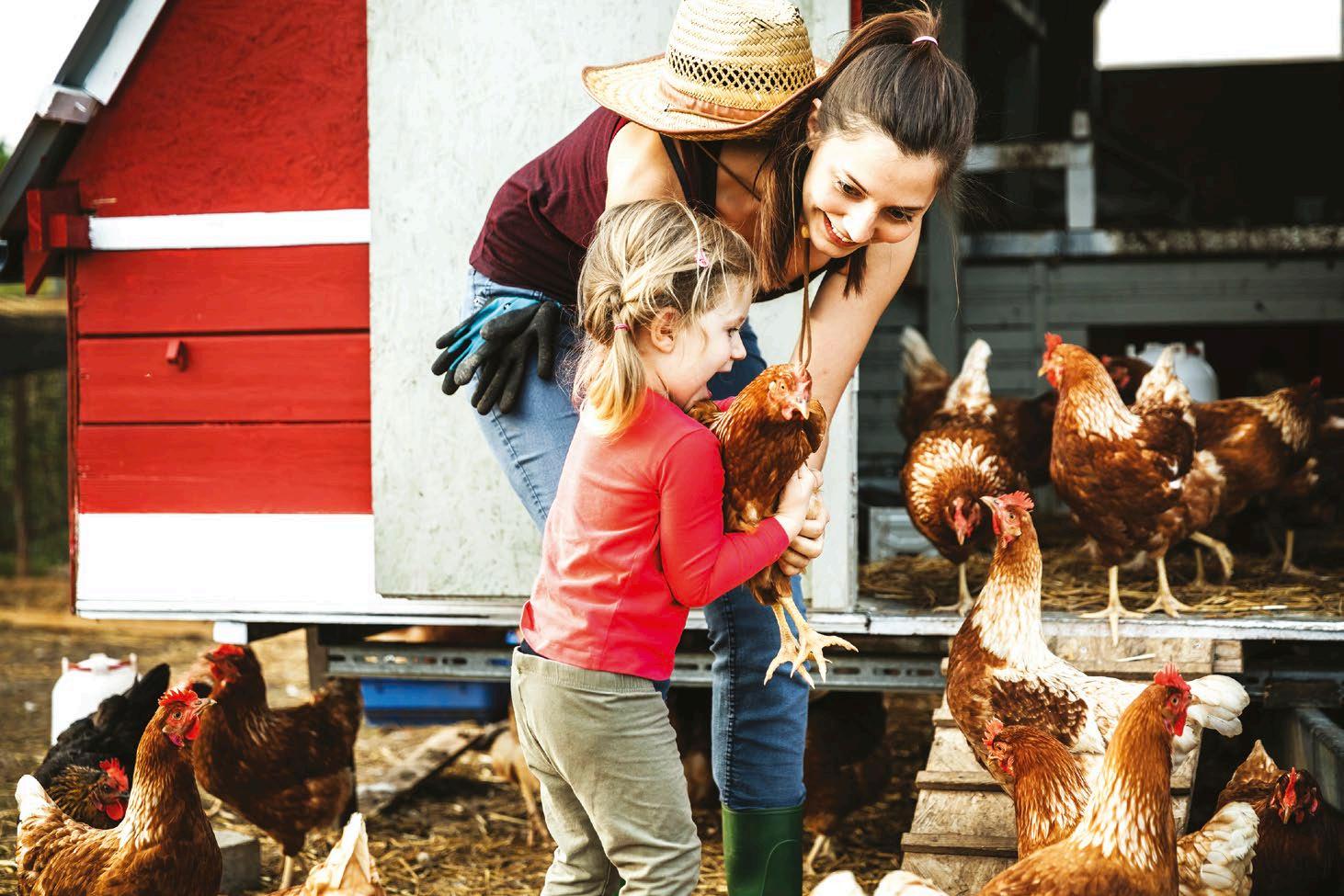

During the past 22 to 24 August, the WPSA UK Branch held the 33rd Poultry Science Symposium at Clare College, Cambridge. This year the symposium was focused on “Pre-and Probiotics: Nutritional, veterinary and production perspectives.”
From aviNews International, we interviewed Dr. Helen Masey O’Neill to talk about specific details about the symposium and the WPSA UK Branch.
 Dr. Helen Masey O’Neill1 and Maria Camila Alfaro2
1 PhD. Chair of Symposium-WPSA UK Branch. Innovation Director at ABAgri
2 DVM. MS. KAM aviNews International
Dr. Helen Masey O’Neill1 and Maria Camila Alfaro2
1 PhD. Chair of Symposium-WPSA UK Branch. Innovation Director at ABAgri
2 DVM. MS. KAM aviNews International
The Symposium happens every 3rd year and is an opportunity for our Branch to develop an agenda on a specific area of interest to the community. We tend to use international invited speakers to cover the topic in detail with some submitted posters.
The goals of our branch are knowledge transfer, application of science, supporting education, liaison with industry, and worldwide exchange. Holding Symposia and our Annual Spring Meeting are some of the main ways we achieve these goals.
I
Our branch is a charity, and to run such events for the industry, we depend on our community and our supporters.
Sponsorship from generous industry members is critically important to enable us to hold our Symposia. We couldn’t run the meetings without our Sponsors, and we are very grateful for their contributions to the community.
We don’t aim to profit from Symposia, but we do use some donations to enable community value, such as student and early career attendance scholarships.
We haven’t had a nutrition-themed Symposia for several years. There is so much work ongoing in our sector to use less and fewer medicines and a lot of developments in gut health and additive use.
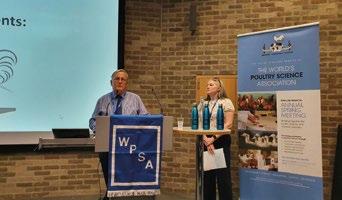
Our Spring Meeting is often very nutritionoriented in topic, so we thought at this Symposia we could aim to bring in as many other perspectives from our veterinary and production colleagues.


All these approaches will need to be integrated for good gut health and medicine

Why is the Poultry Science Symposium series important to the WPSA-UK Branch?
Can you tell us a bit about the Agenda, Pre and Probiotics, Nutritional, Veterinary and Performance perspectives?
notice lots of interesting Sponsors. Can you comment on that?
There were several themes that emerged. There is a lack of consistency in how to define a healthy gut and how to measure it. Several ideas and perspectives were presented, from looking at species abundance to using biomarkers.
Collectively, probably not, but for many attendees, hearing details from practitioners in another field usefully opened some eyes to the barriers between innovation and implementation.
An urgent need was identified to ensure poultry do not contribute to the spread of AMR.
Our industry is very aware of this, and antibiotic stewardship has allowed us to make significant headway. In summary, there are many new innovations, including bacteriophage, that bring new solutions to the field of gut health.

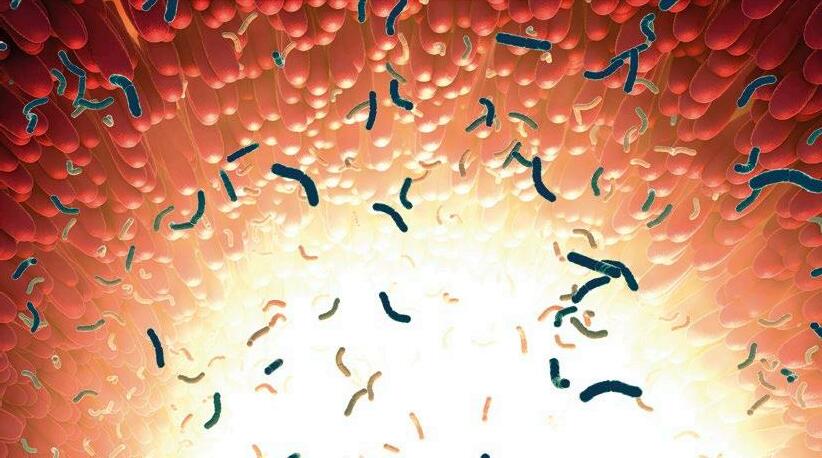
However, it was also noted that additives are not the sole solution to improving gut health: good husbandry and collective thinking among stakeholders are essential.
Over the long term, we hope that some people are inspired to develop new innovations in years to come.
Over the short term, we hope there will be some refinement in practice and renewed effort in communication.
This Symposium series also publishes a book which becomes a useful reference text on the topic. Watch this space!

The World’s Poultry Science Association exists to promote excellence in poultry science, husbandry, and education.
Our UK branch was established in 1946 and is a registered charity run by an elected Council of Trustees with representatives from academia, science, and industry.

Did any key themes come out of the meeting? Did any surprises emerge from bringing such diverse people together?
It is an important objective of the branch that we actively support:


As such, we offer various funding opportunities, such as travel grants, summer vacation scholarships, and research awards. Further information can be found on our website.
Membership of WPSA (UK branch) is open to anyone with an interest in the poultry industry and poultry science. Benefits of membership include:
Of course, all poultry producers are welcome to join the branch and also attend meetings. Some of our funding awards are also available to those working in the



 By Ad Bal
By Ad Bal
AVEC is the voice of Europe’s poultry meat sector. Newly elected president Gert Jan Oplaat strongly advocates the value of poultry meat and getting it on every table of European families. “My goal is to tackle an array of challenges. In particular bridging the gap with the “Brussels bubble”.
“Poultry meat on every table in Europe”
Since last September, Gert Jan Oplaat from The Netherlands is the new president of AVEC, the Association of Poultry Processors and Poultry Trade in the EU. During the annual assembly in Riga, Lithuania, he was elected to succeed Paul Lopez from France who has been AVEC president since 2014.
“Poultry meat is superb food”, says Gert Jan. “And I believe that getting it on every table is possible. In my speech, addressing the audience at the summit in Riga, I highlighted the many benefits of poultry meat. In theory, poultry meat should be within reach for everybody. It is easily and quickly to produce and it is affordable. Moreover, it originates from chicken which has the lowest feed conversation ratio (FCR), compared to other kinds of animals.
As a result, poultry has the lowest carbon footprint, in some cases even lower than products from plant origin like cashew nuts.
Not just that, poultry meat can be on the menu everywhere as it has not any religious limitation. Apart from the “vegan religion” of course..”, Gert Jan adds.
“At this moment, poultry has surpassed pork already in meat consumption globally”, he continues. “In The Netherlands, annual poultry consumption per capita is 22 kilograms, like it is in Asia. In the USA, poultry consumption is no less than 51 kilograms per capita!

Yet, although affordable, poultry meat is still not accessible for everyone. We must realize that in today’s modern world, still many people are malnourished.
Currently, the world population counts by around 7 billion people and this number is forecast to grow up to 10 billion in the year 2050. With major cities (in primarily Asia) of up to 50 million citizens! At the same time, we must realize that of the current 7 billion world population, 2 million don’t have access to a daily meal, also in the developed world!
Hence, poultry can play a major role in providing food for the poor. In my home country The Netherlands, I am also the president of Dutch association and AVEC member, Nepluvi. This explains my involvement in AVEC, by the way.
True to tradition, at Nepluvi we cater the annual barbecue of our parliament members. Since parliament is temporarily housed in a different facility because of a major reconstruction of the building, the barbecue couldn’t take place this year. Instead, we decided to cater the foodbank in the city of The Hague where our parliament is based.
Together with this foodbank we organized an “open social chicken BBQ”, which attracted no less than 1,500 people! This figure makes you thinking about what valuable food means to people...
At AVEC, we represent the European poultry processing and trading business. Each country has its own, or even two associations, all with their own mission and goals and these are all members of AVEC.
In this European organization, we join forces and together we aim for the best possible production and trading conditions and a level playing field for all countries.
Together we represent 23,000 family businesses with 350,000 employees across the EU and UK, with a turnover value of by around 38 billion euros. This is truly serious business!
As a result, we must do our utmost for our members to not just earn a good living, but also keep producing affordable chicken for the European population. That also makes you realize that not just our own Nepluvi organization, but also AVEC can play an important role in “providing food to the poor”.

In this context, there’s a job to do for AVEC. As a European poultry processing and trading community, we balance between the “Brussels bubble” with its politicians, NGO’s and the real world in which we all live and work.
However, we observe that many people from the Brussels bubble and NGO’s have lost the awareness about where they came from. There’s a gap between them and the real world. After all, they don’t have to worry about their income. They receive their monthly salary, all kinds of remunerations and have free time to spend.
The NGO’s are well organized and receive lots of funding. Whereas at AVEC we debate about either or not spend a fee of a couple of thousand euros. This is because our members are all entrepreneurs and must earn their own living. And they have their worries.
In my new role as President of AVEC, my objective and also responsibility is:
to tackle quite a number of challenges in poultry production, processing and trade. That all starts with bridging the gap between the Brussels bubble and the real world.
We are absolutely not against everything, on the contrary! It would be the best to stay side by side and team up.
All with the aim to facilitating professional poultry production across Europe. Allowing poultry growers and processors to properly do their jobs. Convince (and reset!) EFSA (European Food Safety Authority) about professional (not theoretic) ways of bird handling, setting up an Avian Influenza (AI) vaccination program with EU funding and enter into new trade negotiations. Together with the AVEC team, we will define a priority list and address these topics. One thing will stay top priority: “Bringing poultry meat on every table in Europe”. Now is the moment!
Founded in 1996, AVEC is the Association of Poultry Processors and Poultry Trade in the EU. In other words, the voice of the European poultry meat sector. AVEC facilitates communication and exchange between international organizations and decision-makers, and focuses on key areas like:
animal health and welfare, food safety and quality, trade and sustainable development.
In AVEC, 19 organizations from 16 EU member states and the UK are united. The member organizations meet once every year during their annual assembly. This year the assembly was held in Riga, Lithuania, where acting President Paul Lopez was succeeded by Gert Jan Oplaat from the Netherlands.
By advocating for coherent European policies which will work on the global stage, AVEC is ensuring the development of a solid and thriving European poultry meat sector.

Information: avec-poultry.eu
Interview with Gert Jan Oplaat, President AVEC
DOWNLOAD THE PDF
Modern laying hens deliver top performance. That demands proper skills and adequate management. Layer farmer Peter Janssen from The Netherlands knows exactly what to do to keep his flocks in top condition till the end of their productive life.

Over the past decades, professional layer breeding took egg production around the globe to an unprecedented level. Today’s modern hybrid birds are incomparable with the backyard bird of the past. These lay an egg by now and then, depending on their age and condition. That’s about it.
Modern layers, however, nowadays are able to produce even up to 500 eggs in their life span of about one hundred weeks. Clearly these birds are “top athletes”.
Peter Janssen, general manager of the family owned Janssen egg farm, very well understands how to manage such flocks.
His farm is based in the village of Ysselsteyn in the Southern part of The Netherlands.
Peter took his position as general manager in the year 2000. In those days in The Netherlands, the transition from keeping layers in battery cages to free range and aviary systems was gaining ground.
Raising and keeping such layers is not just a matter of putting them in a house, provide feed and water and collect eggs. On the contrary! These birds have been bred to be kept in large flocks for commercial purposes. As a result, adequate and professional management is a prerequisite to let such flocks be productive.
Photo 1. Peter Janssen is keeping 285,000 Dekalb White and Lohmann White layers in 4 different ages and in 4 houses
Based on his experience and knowledge of these systems ever since, today Peter is in command of 285,000 Dekalb White and Lohmann White layers in 4 different ages (Photo 1).
These are kept in 4 houses, with two or three storeys respectively and a capacity of 72,000 birds each.
All houses are equipped with aviary systems, so the layers have plenty of room for movement and roaming around.

“Successful production starts at the very beginning”,
says Peter.
“In other words, from the moment of rearing of the day-old chick up to an 18 week old pullet.”
In the structure of many family owned farms in The Netherlands, rearing usually takes place on specialized farms, which are under contract with the layer hatchery. At an age of about 17-18 weeks these young pullets move to the specialized farm, where at an age of by around 20 weeks egg production starts.
Usually there’s no choice for the layer farmer where the chicks are reared. Peter Janssen, however, is keen to working with rearing farmers he personally knows and in which he has great confidence.

“We consider their professionalism and skills of great importance, as this is the basis of a productive flock,”
according to Peter “An important aspect is also the right feed for young, growing pullets. For that reason, we are in close contact with our feed supplier and if needed we adjust the feed formulation to the condition of the growing pullets.”
At the age of 17 weeks, the pullets move to Peter Janssen’s layer farm. Every 19 weeks a young flock comes in, after a 2 weeks downtime for cleaning and disinfection of the house.
“We consider receiving them at this early age essential” (Photo 2),
Peter continues
“After all, catching and transporting these young hens to a new environment is a stressful event. When they arrive at 17 weeks of age, they will have sufficient time to accommodate to new living conditions, get used to the new environment, find out where to lay eggs once that is going to start and so on.
These are still young birds, and they need time to fully grow to their target weight. This is important, as a fully developed bird is essential for its health and a long-lasting productive life. For that same reason, we also don’t start the lighting program too early. That may cost some early production, that’s true.
However, egg weight will surpass 53 grams fairly quickly, so that will compensate for the delayed onset of lay. Moreover, a well-developed layer will be able to longer persist at the end of the laying period.” (Photo 3)

“Once the pullets are in the house, I intensively and permanently observe the flocks” says Peter. “After all, we must be convinced that the birds feel well
They have non-trimmed beaks, so we wish to absolutely avoid cannibalism.
I observe their behavior: if they use the hay bales for distraction, if they dust bath, if is there a quiet atmosphere in the house, what do I hear and smell etcetera.
Photo 3. A well-developed layer will be able to longer persist at the end of the laying period.
Apart from my own daily observations, we have a regular meeting every few weeks with the veterinarian, nutritionist, a caretaker of my own staff and myself. Together we observe and discuss the condition of the young flocks.
Up to 30 weeks of age, we consider development of the birds important, whereas after 50 weeks of age the focus will be on maintaining good egg quality. If needed, we undertake action. This can be applying medication, changing the feed formulation or other measures, whatever we find appropriate.” (Photo 4)
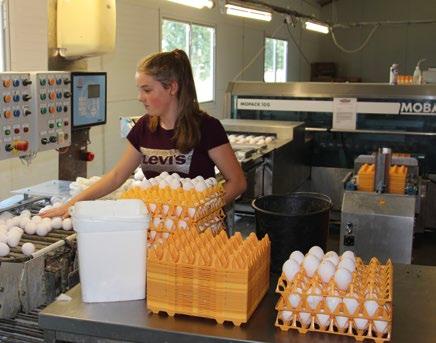

“Absolutely an important aspect is the climate inside the house, in order to keep the layer flock comfortable and productive”, Peter continues (Photo 5)
“For that reason, proper ventilation is essential. We permanently measure temperature and relative humidity. As important, is odor as this indicates the ammonia emission. In order to keep this at a low rate, manure is pre-dried.
Photo 4. After 50 weeks of age of the flock, focus is on maintaining good egg qualityFor this purpose, we aerate the aviary system with air from inside the house, thus keeping ammonia emission at a low level.
The manure belts from the aviary system run into and through a drying tunnel at the backend of the house (Photo 6).
Since we take out the manure on a daily basis, we keep ammonia emission inside the house at a low level.
Inside the tunnel, we also dry the manure with warm exhaust air from the house. Hence, the manure dries quickly and thus also here ammonia is fixed and emission kept at a low level.”
At the end of the drying tunnel, the manure has reached a dry matter content of 80 percent. Once the manure leaves the house it ends up in a storage chamber, from where it is distributed as valuable fertilizer (Photo 7)

Once production of a flock has over the course of time dropped up till 80 percent, the hens are culled at an age of about 93-95 weeks. “We don’t want to get the very last egg out of our layers”, Peter Janssen concludes.

Photo 7. Once the manure leaves the house it ends up in a storage chamber, from where it is distributed as valuable fertilizer
“The hens have done their utmost and egg quality is not too good anymore. The flocks have delivered top performance, for which we have given the best care and management we could. That’s essential to keep them in top condition up till the end of their productive life.”
Source: Dutch Poultry Centre https://dutchpoultrycentre.nl/en/
The art of keeping layers in top condition
DOWNLOAD THE PDF
Photo 6. Manure belts from the aviary system run into and through a drying tunnel at the backend of the house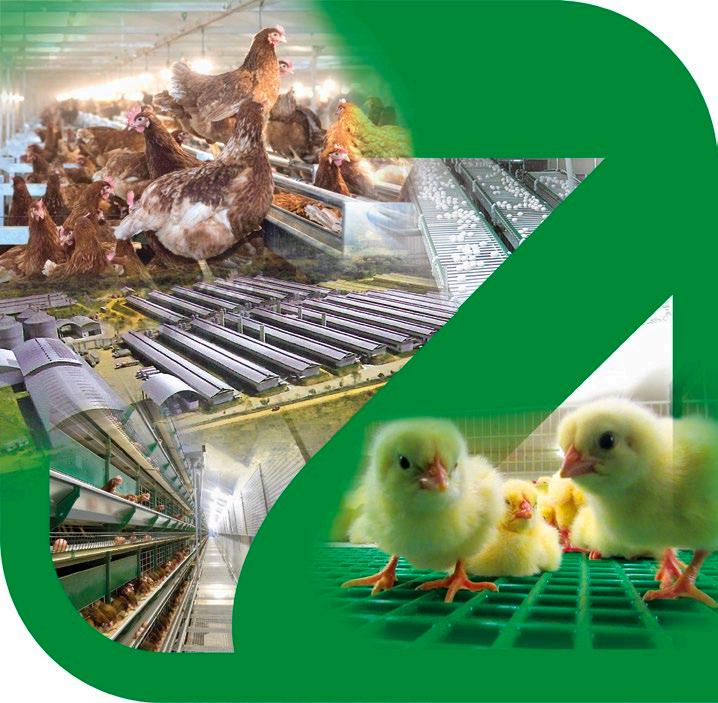
The 26th World’s Poultry Congress held in Paris between August 7 and 11 was a success. The Congress originally planned for summer 2020 was postponed twice due to the pandemic. However, organizers were able to modify the traditional format of this quadrennial event and develop a hybrid event.

The Congress started in September 2021 with a series of 12 webinar sessions that concluded in May 2022. The first group of abstracts was published in 2021, and the first ePosters were made available online.
 State University, Raleigh, NC, 27695
State University, Raleigh, NC, 27695
During webinars before the event in Paris, each one of the working groups of the World’s Poultry Association discussed topics like: Turkeys, Construction of meat quality and Meat processing, Egg quality, Poultry welfare and management, Hygiene and Pathology, Physiology, Feed Technology, Breeding and genetics, Waterfowls, New (or alternative) Feedstuffs, Small Scale Family Poultry Farming, and Incubation and Reproduction.
The organization reported that a total of 1,993 participants met in Paris, and 571 were virtually engaged. Participants represented 85 countries in all world regions.

Approximately 48% of participants in Paris came from Europe, 16.9% from Asia, 14.6% from the Americas, 10.9% from Africa, 7.9% from the Middle East, and 1.7% from Oceania. In eleven plenary sessions, 12 speakers addressed the major topics discussed in the poultry sector. These topics included:

Economy and sustainability of the poultry production chain
One health – one welfare
The bird and its microbiota
Breeding and nutritional strategies for sustainable poultry production schemes
New frontiers in poultry science
Forty-five parallel sessions were conducted with 38 invited speakers and 179 short oral communications. The speakers originated from 47 countries.
Oral presentations were organized in 17 object-oriented sessions that addressed a combination of approaches to study and propose solutions to interactions between nutrition, genetics, and epigenetics, with the management of broiler breeders or the early management of the embryo, or with new approaches such as robotics.
The other 28 sessions were specialized and defined according to WPSA working groups’ domains.
events
Thirty-five sponsors supported this global event. Ten sponsor companies organized technical symposia during lunch or at the end of the sessions in the afternoons. These companies included:
Adisseo hosted the opening conference on the water as a critical factor for sustainable nutrition. Almost 1,000 people attended this session on Sunday, August 7, in the afternoon.
On Monday, DSM discussed the precise management of the microbiome.
Novus Launched a book entitled Breeder Management and Nutrition.
Elanco had five talks about poultry health linked to profitability.



Phileo’s symposium was related to the role of microbiota on immunity, boosting innate immunity and reducing the harmful effects of DON mycotoxin.
IFF discussed the impact of the environment on optimizing phytase dose, matrix values for enzyme use, and the combination of enzymes and probiotics.
The symposia from Metex Noovistago addressed the role of functional amino acids on diverse aspects of gut health for broilers facing production challenges.
Ceva had one talk related to the ideal In Ovo vaccination process.
Speakers at the CHR Hansen symposium discussed the healthy microbiome to reduce pathogen translocation and lameness and the effects of gut microbes and feed additives on broiler performance.
Finally, at Zinpro, several talks discussed how trace minerals could improve performance, gut health, immunity, and welfare.
With the launch of the book Breeder Management and Nutrition, which can be obtained on this website from NOVUS, Adisseo launched nestor, a service to obtain nutritional recommendations to formulate a diet for monogastric animals based on the net energy system.
The papers presented had excellent quality, and after three calls for submission of abstracts, 1,225 were accepted and published in three volumes of proceedings. This was the first-time virtual poster presentations were used, and 653 ePosters were available All information, webinars, posters, and oral presentations are available on the WPC 2022 platform until December 31st.
Rick Van Emous
Wageningen UniversityNovus International author's book
Mercedes Vazquez Novus International author's book
Effects of breeder feed restriction on behaviour, welfare, reproduction, and health
Harnessing epigenetics to improve chick quality with trace mineral zinc

Mario Penz Cargill
Alleen Magumbi
The program also provided the opportunity to revive the African Poultry Network and the Small-Scale Family Poultry Farming working group, which launched a process to establish their strategic agendas.
AviNews International was present at this event and interviewed recognized scientists and technical personnel from many global companies and institutions to discuss multiple topics. These interviews are available on the YouTube channel and aviNews International website:

Impact of the current grain markets in poultry worldwide and the strategies to solve the shortage of ingredients.
Broiler grower- Ulusoy Africa Poultry Broiler production experience in South Africa
Marco Rebollo Zinpro Corporation
The first line of defense and gut health.
Zehava Uni Hebrew University of Jerusalem Benefits of in-ovo feeding on chick development
Martin Zuidhof
University of Alberta Use and effects of precision feeding in broiler breeders
Samuel Aggrey University of Georgia Feed efficiency in broilers
Edgar Oviedo
North Carolina State University
Roselina Angel
Bapon Dey
Comfort Acheampong
Massimiliano Petracci
University of Maryland
Importance of data analytics in the poultry industry and new trends.
Calcium effects on broiler development and how the calcium requirements have changed.
Bangladesh Agriculture University Layer nutrition and egg quality in Bangladesh
Ghana National Egg Campaing Secreteriat GNECS. Egg production in Ghana
University of Bologna Broiler breast abnormalities
The next World’s Poultry Congress will be held in Toronto, Canada, in 2026. This event will be organized by the Canadian, American, and Mexican

The WPSA is a world non-profit organization with a membership of


It still takes a lot to crack a LOHMANN egg –
now more than ever!


